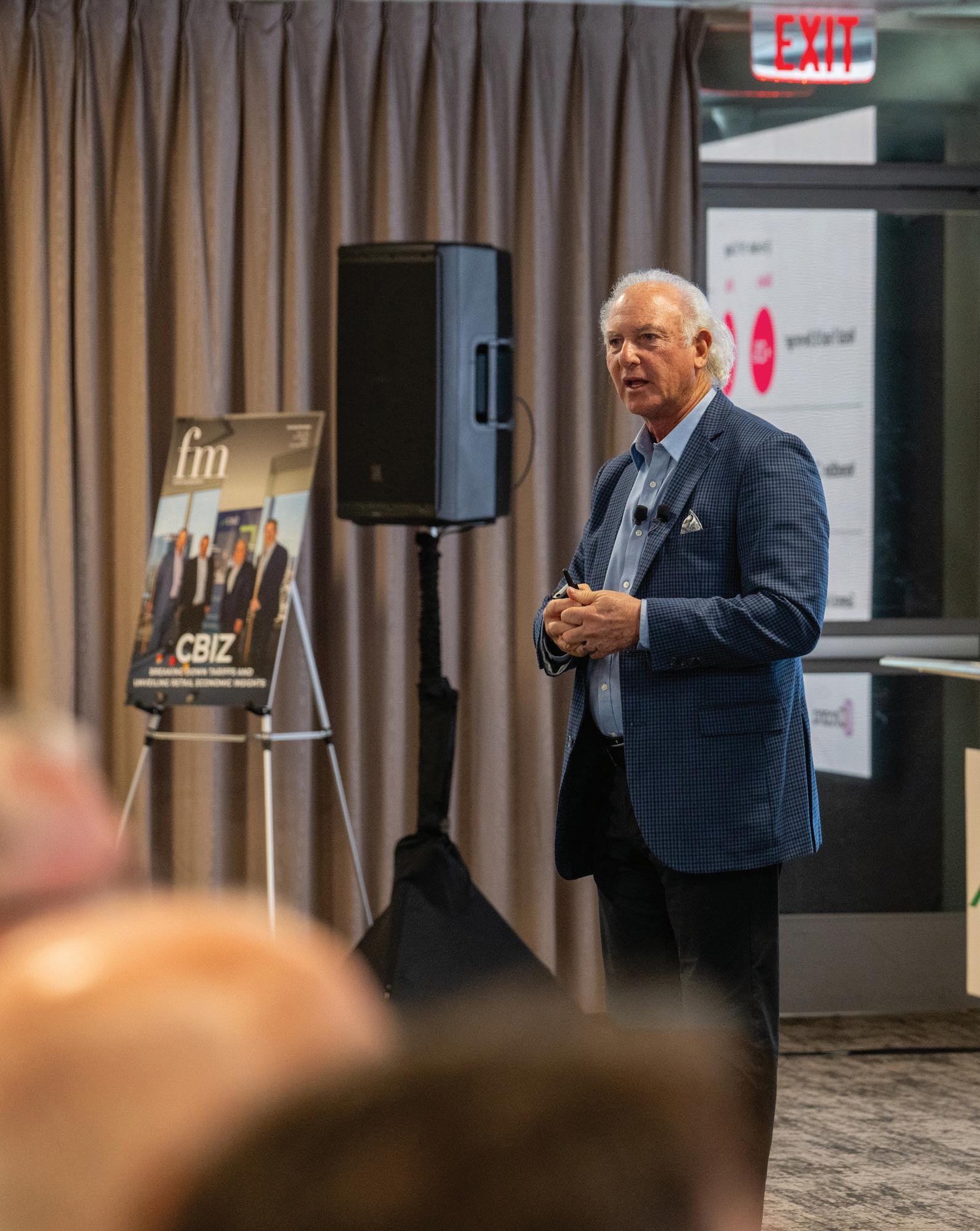


















In shifting markets, we’re taking the long view, so you can seize the moment — now and for years to come.











































































































EDITORIAL
Editor
Debra Hazel
Director of Communications and Marketing
Penelope Herrera
Director of
Newsletter Division
Cheri Phillips
PRESIDENT/CEO
Jeff Mann
ART
Art Director
Caroline Thomas
Cover Photography
The New Terminal One
Jared Antin
Sean Burke
Frank DeLucia
Aaron Gries
Kris Kiser
Bob Knakal
Stuart Saft
Carol A. Sigmond
Technology Consultant Eric Loh
Distribution Mitchell’s Delivery Service
DIGITAL MEDIA
Designers
Caroline Thomas
Editors
Debra Hazel
Penelope Herrera
Cheri Phillips
Web Developer CS Designworks
West Coast Office: 578 Washington Blvd., Suite 827
Marina Del Rey, CA 90292 866-306-MANN (6266) mannpublications.com



East Coast Office: 450 7th Ave, Suite 2306
New York, NY 10123 212-840-MANN (6266)











For 50 years, R&E's attorneys have been instrumental in driving the firm's success, helping R&E achieve remarkable milestones and putting the firm at the forefront of the real estate industry.


We’re certainly living in some interesting times — and yes, I know that’s an Asian curse — but it’s thrilling to see how New York City developers are continuing to reinvent buildings around the city.
Last month, of course, we celebrated the conversion of One Wall Street from offices to luxury residences and retail. This month, our cover focuses on a development that is long overdue — creating a world-class gateway to our city and our country with the creation of JFK’s New Terminal One. The addition of exceptional retail from around the world — and around Queens — to a stunning new terminal is just the introduction all of our visitors should have to our city. I can’t wait until it’s completed in 2030.
Speaking of retail, Mann Publications was delighted once again to be a sponsor of Cbiz’ Annual Retail Symposium in Los Angeles, which discussed the challenges and opportunities facing the sector right now. My dear friend Marshal Cohen of Circana once again delighted and educated the audience about all trends affecting this critical sector, while a group of retailers and manufacturers offered a behind-the scenes look at how they’re dealing with the current volatility. Look for images and a summary of the event from Editor (and long-time retail maven) Debra Hazel in these pages.
Look for Debra at ICSC Las Vegas this month, and come right back here for our June/July double issue.
See you then!

“You walk into a retail store, whatever it is, and if there’s a sense of entertainment and excitement and electricity, you wanna be there.” — Howard Schultz




















FRESH MEADOW COUNTRY CLUB 255 LAKEVILLE ROAD, LAKE SUCCESS, NY
CO-CHAIRS
DENNIS HERMAN
CHAIRMAN & CEO
BEEKMAN INTERNATIONAL CENTER, LTD.
GARY JACOB EXECUTIVE VP GLENWOOD MANAGEMENT
GOLF COMMITTEE
FREDERICK W. BARNEY, JR
ROBERT EICHLER
MICHAEL HIGHT
JAMES A. INGRAM
GERARD F. JOYCE JR
SAMUEL WAXMAN, MD
ARI ZAGDANSKI











Welcome to my favorite issue of the year, where we discuss all things retail.
If you’ve been reading Mann Report for a while, you probably know that I began my career writing about retail real estate as the “malling of America” was wrapping up, followed by the “power centering of America,” the “lifestyle centering of America” and more. All of those, of course, were punctuated by the occasional — and false — “mall is dead” pronouncements.
Let’s just say I’ve seen a lot of retail changes, and that’s what makes this sector so interesting. It has to react to consumer and economic shifts seemingly overnight — and the best retailers and landlords do so.
deal with changing conditions. We help you turn challenges into opportunities through innovative and insightful thinking. Cash flow planning, gross profit by product line, chargeback analysis, assistance with access to capital, and operational improvements are just a few ways we help fashion companies gain an edge.
Now, of course, we’re facing yet another set of challenges and opportunities, as you’ll see in our cover feature on the retail coming to JFK’s New Terminal One. West Ridge Mall’s conversion of outmoded space to offices and openair retail is a model for other reimaginings. And learn from the inside how many retailers and manufacturers are coping with the ever-changing tariff situation through our feature on Cbiz’ annual symposium.
We provide a wide range of financial reporting, tax and advisory services to make your business and finances stronger.
As always, I’ll be at ICSC Las Vegas this month — get in touch to set up a time to discuss how you’re reinventing retail!


Langsam Property Services Corp. held a celebratory 75th anniversary party at Bally’s Ferry Point Golf Links in the Bronx. Over 200 staff, friends, vendors and public officials joined to celebrate the mammoth occasion.
Langsam CEO Mark Engel and President Matt Engel both spoke about the firm’s rich history. Langsam was founded in 1949 by Ralph Langsam, a World War II bombardier who returned from Europe and created the firm to help run properties for his family. Over its first 25 years, Langsam expanded and became a leader in the Bronx, operating both family properties as well as third party-owned apartment buildings. Throughout the 1970s and 1980s the firm, under Mark Engel’s leadership, the firm oversaw the renovation of thousands of vacant apartments during the difficult days of the Burning Bronx.
Since Matt Engel joined 15 years ago, Langsam has broadened its management services throughout New York City and become a leader in third-party management of rent-regulated and tax credit affordable housing properties. At the party, Langsam was joined by Bronx Borough President Vanessa Gibson and several members of the Bronx City Council, State Senate and State Assembly delegation.











The Seventh Annual Consumer Products & Retail Symposium, now under the Cbiz banner, was an outstanding success, setting a new benchmark with over 200 participants — the highest attendance to date! Returning with vigor, the symposium showcased an engaging and insightful agenda focused on consumer behavior and retail trends, particularly in the context of the evolving tariff landscape.
Attendees were treated to unparalleled networking opportunities with industry leaders, including retailers, manufacturers and service providers in consumer electronics, toys, accessories, food & beverage, beauty, apparel, e-commerce and more.
The event commenced with networking, followed by opening remarks from Ron Friedman, consumer and ondustrial products leader at Cbiz. A riveting presentation by Robert Krieger, president and CEO of Krieger Worldwide, explored “Tariffs and Their Toll on Retail,” introduced by Jeff Mann, CEO of Mann Publications. The keynote address, “Retail – The Perfect Storm – It’s A Lot More Than Just Tariffs,” by Marshal Cohen, chief retail advisor at Circana, captivated the audience and ignited engaging conversation.
Participants then navigated the complexities of new tariffs in an Executive Panel moderated by Trever Acers, managing director at Objective Investment Banking & Valuation with insights from Tim Johnson, CFO of Buck Mason; Brian Kessler, CBO of Kessler Corporation and Linda Wang, founder and CEO, Karuna Skin & Avatara Personal Care. The symposium concluded with a dynamic Q&A session and closing remarks from Brian Rabinovitz, business development leader at Cbiz, followed by a lively networking and cocktail reception.















Photos by Leslye Smith, Andrés Piedrahita and John Scott Lucas
Creative Art Works (CAW) welcomed 500 supporters, partners, staff, teaching artists, students and Youth Apprentices to the GM Building’s Savoy Club for its Annual Benefit for Kids. The benefit, CAW’s most important fundraiser of the year, raised $1.25 million for CAW’s vital arts education and creative youth development programming, which impacts thousands of New York City children, teens and young adults every year.
Attendees enjoyed drinks, hors d’oeuvres and more than 300 works of youth-created art, as well as the opportunity to speak to a few of the teens and young adults who had created them. The 2025 Benefit Honorees were Jeffrey Sussman, executive vice president, Edward J. Minskoff Equities; Joseph Fitzpatrick, partner and president, TDX Construction Corporation and Paul Capurso, executive secretarytreasurer pro tem, NYC and Vicinity District Council of Carpenters. CAW also honored its program partner Charles Reilly, the principal of PS 368, The William B. Lynch School.














The NYU School of Professional Studies Schack Institute of Real Estate hosted its 29th Annual REIT Symposium. At this year’s event, industry experts, trailblazers and visionaries shared their insights and analysis on the latest macroeconomic outlook and trends, the impact of technology on the industry, market conditions and opportunities for commercial real estate and REIT investment in 2025.



Brian Kingston (right), Brookfield, discussed the company’s long-term investment strategy and shared his perspective on the evolving nature of the global real estate market in a conversation led by Marc Norman, Larry & Klara Silverstein chair and associate dean of NYU SPS Schack Institute of Real Estate.

Robin Panovka, Wachtell, Lipton, Rosen & Katz and NYU SPS REIT Symposium co-chair, moderated a discussion with Mark Ganzi, CEO of Digital Bridge, on the importance of AI and data in driving smarter, more efficient operations, from predictive maintenance to capital deployment.





• Anti-odor StayFreshTM treament by Polygiene®
• Durable ripstop polyester with water resistant coating
• Front quick-access zippered pocket
• Anti-wrinkle garment bars
• Full-length middle and bottom zippered opening
• Two internal mesh zippered pockets
• Internal adjustable hanging loop secures multiple hangers
• Multi-use carry handle for hanging
• Bi- or tri-fold carry/packing options
• Two seperated slip-through openings for additional hanging options
• Gusseted sides




Newmark Group Inc. has arranged the $105 million sale of 1601 Vine, a premier Class A office building located in the Hollywood submarket of Los Angeles. The 115,589-square foot building is 100% leased, anchored by Skims Body Inc. (Skims).
Newmark Co-Head of U.S. Capital Markets Kevin Shannon, Executive Vice Chairman and Head of International Capital Markets Alex Foshay,
Vice Chairmen Ken White, Rob Hannan, Laura Stumm and Michael Moll, Executive Managing Director Bill Bloodgood and Director Alex Bergeson represented the seller, Snyder Vine LLC. The buyer was Kingsbarn Realty Capital. Newmark Co-President of Global Debt and Structured Finance Jonathan Firestone and Director Henry Cassiday provided support on debt strategy and financing considerations throughout the transaction process.
“Capital is showing renewed conviction in high-quality, 2025-vintage office investments,” said Shannon. “Top-tier tenants like Skims are prioritizing best-in-class buildings, and contrarian investors are capitalizing on the opportunity to acquire premier office product below replacement cost with historically attractive cap rates.”
Delivered in 2017 by JH Snyder Company, the property was extensively renovated in 2024 to deliver a world-class headquarters for Skims. The property features high-volume ceilings, a limestone lobby with terrazzo flooring, floor-to-ceiling windows offering panoramic views of Hollywood, high-impact executive suites and on-site photography studios.
“Skims’ long-term commitment to 1601 Vine reflects a broader returnto-office trend. For Skims, in-person collaboration is essential — especially in a tactile, design-led industry like apparel,” Stumm added. “Their 15-year lease signals a strong belief in the long-term value of a physical workspace to foster creativity, culture and innovation.”

As corporations worldwide continue to adjust their hybrid policies to favor in-office attendance, the office sector has regained a central role in commercial real estate. But improving individiual office spaces to suit current needs comes at a price, reported JLL in its “Global Office Fit-Out Costs Guide 2025,” which analyzed data from 68 cities in 40 countries around the globe.
Across all regions surveyed, office fit-out costs have increased in the last 12 months to varying degrees. With 59% of organizations globally planning to increase investment in space design, multinational corporations must understand regional disparities in office fit-out costs to inform strategic planning. As with previous years, JLL found fit-out costs are highest in U.S., Canada, United Kingdom, Switzerland, Saudi Arabia and United Arab Emirates, Singapore and Japan.
“Five years following the start of the global pandemic, we continue to see the evolution and growing momentum toward the office sector,” said Cynthia Kantor, CEO, project and development services, work dynamics. “While global fit-out costs vary greatly, depending on regulations, design preferences and functional requirements, our team and the ‘Global Office Fit-Out Costs Guide’ helps organizations plan their office spaces and projects in the face of market uncertainty.”
Regionally, a significant premium for office fit-outs is commanded by North America, where the average fit-out cost is $3,070 per square meter, compared to the global average of $1,830 per square meter. In Latin America, the average fit out cost is $1,790, followed by Europe, the Middle East and Africa, which present a wide range of office fit-out costs, with an average of $1,970. Asia Pacific offers the lowest regional average fit-out cost at $1,460.
Global variations between major cities also persist. U.S. cities dominate the top 20 cities by office fit-out cost globally, alongside other major cities such as Vancouver, Tokyo, London and Dubai. Alternatively, global cities with high growth across India, South Africa, Vietnam and China offer among the lowest fit-out costs globally, though they are actively experiencing high construction growth and an evolving cost landscape.
Of the markets assessed, fit-out cost increases over the last 12 months were driven by inflation, material costs and currency volatility. Threequarters of markets reported increases in raw material prices, and half have experienced labor shortages in the last 12 months that have increased construction costs.
Amid growing interest in healthier, energy-efficient workspaces, paired with the friction created by a lack of immediate supply, demand for sustainable fit-outs is on the rise, with 60% of markets surveyed reporting an increase in client inquiries for a more sustainable fit-out in the last 12 months.
CardVault by Tom Brady, a sports card and memorabilia retailer, has opened its newest flagship location at American Dream in East Rutherford, N.J., next to MetLife Stadium. This location is the first CardVault store outside the Boston area and the first fully branded store since former NFL quarterback Brady acquired an ownership stake.
Spanning over 1,200 square feet of immersive and interactive retail space, CardVault by Tom Brady at American Dream offers rare and premium trading cards, authentication services and an exclusive VIP trading experience. Operated by a team of passionate hobby experts, the store aims to provide a welcoming and insightful environment for collectors, novices and sports fans alike, guiding visitors through the rich history and exciting future of the hobby.
“We’re just getting started,” Brady said. “I’m beyond excited to officially be in the hobby — not just as a collector, but as a store owner. CardVault isn’t just about buying and selling cards; it’s about bringing the passion of collecting to as many people as possible. Collecting is about more than just the cards, it’s about the memories, nostalgia and the connection to the game. I’ve lived it firsthand, and I know how powerful that feeling is. We’re bringing that excitement to a whole new generation of fans.”
CardVault by Tom Brady is an authorized retailer of Topps, Panini, Upper Deck, Fanatics Authentic and leading trading card game manufacturers, offering a wide selection of sports cards, trading cards, collectibles and authentic memorabilia across all sports, teams and categories. Customers will find sealed packs, boxes, individual cards, signed jerseys and equipment, as well as the latest Pokémon releases and other popular trading card games. Additionally, the store serves as an authorized dealer for the industry’s top grading services,

including PSA, Beckett and SGC, simplifying authentication and grading for collectors.
“Bringing CardVault by Tom Brady to American Dream, just steps from MetLife Stadium — home to countless iconic moments in sports — is a significant milestone for us,” said Ed Kane, co-founder of CardVault by Tom Brady. “With Tom’s vision and American Dream’s unmatched energy, we’re creating a premier hub for fans and the entire sports collecting community.”
The store features a custom-designed steel vault showcasing some of the most sought-after collectibles, Fanatics Approved memorabilia and vibrant artwork complemented by sports-centric murals from artists including a one-of-a-kind sculpture by renowned Southern California artist Brett Crawford.
Soloviev Group has secured three new long-term leases at its flagship property, 9 West 57th St. The deals — signed with Hess Group LLC, Beaconlight Capital LLC and Platinum Equity Advisors LLC — together account for 40,728 rentable square feet of trophy office space.
Hess Group LLC signed for 19,544 rentable square feet, Beaconlight Capital LLC leased 5,281 square feet in the only available space on the newly finished amenity floor and Platinum Equity Advisors LLC, a global investment firm, secured 15,903 rentable square feet on the 46th floor.
“It is an honor and a privilege to welcome Hess Group, Beaconlight Capital and Platinum Equity to the best commercial building in the Stefan Soloviev, chairman of the Soloviev Group. “These new tenancies underscore our commitment to delivering unmatched office space and exceptional amenities in the center of the plaza district, the most sought-after commercial location in the world.”
The building recently completed major upgrades to the lobby, elevator modernization and building system technology. Additionally, as part of its renewed commitment to bolstering the tenant experience, 9 West 57th St. introduced new amenities including a 20,000-squarefoot luxurious amenity floor, offering unparalleled Central Park views, modern conferencing, multi-functional meeting space, a grab & go

coffee bar, executive dining and a hospitality area.
Tenants also have exclusive access to an 11,000-square-foot fitness center that will feature a cold plunge and hot spa-pool, golf simulator, spa-quality locker and shower rooms.




They also have access to the Soloviev Foundation gallery, featuring a quarterly rotation of masterworks by Alberto Giacometti, Henry Matisse, Vincent van Gogh and Jean-Michel Basquiat.


















MONDAY, AUGUST 4, 2025




The Seawane Club | Hewlett Harbor, NY
Rockaway Hunting Club | Lawrence, NY
Hempstead Golf & Country Club | Hempstead, NY




Sunrise Day Camp–Long Island is the world’s first full-summer day camp for children with cancer and their siblings, provided completely free of charge.
Sunrise Day Camp–Long Island is a proud member of the Sunrise Association, whose mission is to bring back the joys of childhood to children with cancer and their siblings worldwide. Sunrise accomplishes this through the creation and oversight of welcoming, inclusive summer day camps, year-round programs and in-hospital recreational activities, all offered free of charge. Sunrise Day Camp–Long Island is a program of the Friedberg JCC, a beneficiary agency of UJA-Federation of New York.



New York-based real estate investment firm Invictus Real Estate Partners, together with real estate private equity firm Integritas Capital, have closed on a $155 million construction completion and condominium inventory loan for Flow House, one of Miami’s fastestselling condo destinations.
Flow House includes a 40-story tower with 466 residential condominium units priced from $450,000. The project features community-oriented amenities and is part of the international Flow brand, which says it is redefining the future of living by putting residents at the center of the real estate experience.
“We were happy to work with Flow to structure a flexible financing solution to convert the rental tower to condominiums. We are excited to be part of this successful project,” said Eric Scheffler and Chris Pardo of Invictus.
Flow House provides residents with homes deliberately crafted with sustainably sourced materials and cutting-edge technology, with select units featuring private balconies and water views. Amenities include a state-of-the-art 24/7 fi tness center with personal trainers and group classes, a meditation room, Pilates studio, cold plunges, sauna facilities and an activated pool deck, all designed to create a seamless and holistic living experience that cultivates a sense of belonging for residents.
Residents also have access to Flow’s state-of-the-art technology, including a dedicated app that centralizes all aspects of the living experience. In this one integrated platform, residents can effortlessly reserve one of the property’s 25 amenity spaces ranging from yoga lawns to conference rooms and register to participate in curated private networking events.
Rendering courtesy of Invictus Real Estate Partners

Strategically located within Miami Worldcenter — the city’s fastestgrowing mixed-use district — Flow House is located near world-class dining, entertainment and cultural attractions, including the Brightline high-speed rail station.
NextHome is the most recent company to join Zillow in its pro-consumer commitment to listing transparency and committing to ensure the largest possible audience of buyers can see its listings. Zillow has introduced new standards for listing access, which are designed to ensure both consumers and agents have equitable, timely access to real estate information — supporting and protecting a more open and competitive housing market.
“Partnering with Zillow to commit to listing transparency is simply the right thing to do for homebuyers and sellers across America. Prioritizing humans over houses is a core value at NextHome because it builds trust and fosters a more informed and confident client base which we believe puts our agents in a position to win,” said James Dwiggins, co-CEO of NextHome. “Through this partnership we are setting a new standard in the industry.”
Zillow’s listing standards outline how it is implementing the National Association of Realtors’ Clear Cooperation policy on its platform. A listing publicly marketed to any buyer must be in the MLS within one day and published on Zillow as well as other sites that receive MLS feeds. Listings that don’t meet these standards won’t be published on Zillow or Trulia for the life of the listing.
“It’s simple: a listing publicly marketed to any buyer should be marketed to all buyers. Hidden listings harm buyers, sellers and agents by creating

an unfair market,” said Errol Samuelson, chief industry development officer at Zillow. “Promoting equal and fair access to all available listings is the right thing to do for sellers, buyers, agents and the industry at large. Zillow is dedicated to putting consumers first and ensuring a fair and open marketplace for all. Those who deliver for consumers will succeed, not the companies putting their own interests ahead of the needs of homebuyers and sellers.”
NextHome has 600 offices and 6,000 agents nationwide and has been named to the Inc 5000 and Entrepreneur 500 franchise lists. NextHome joins Exp in a growing group of real estate industry partners calling for transparent practices prioritizing access for all consumers and agents.
The flow of U.S. residents moving into Florida, Texas and other parts of the Sunbelt slowed significantly in 2024, according to a new report from technology-powered real estate brokerage Redfin.
Tampa had a net inflow of just over 10,000 residents in 2024, less than one-third the 35,000-person net inflow the year before, marking the biggest slowdown in domestic migration of the 50 most populous U.S. metros. Net inflow is how many more U.S. residents move into a metro area than move out; it includes domestic moves only.
Dallas saw the next-biggest slowdown, with a net inflow of roughly 13,000 residents in 2024, down from 35,000 the year before. Next comes Atlanta, which had a net outflow of nearly 2,000 in 2024, meaning 2,000 more U.S. residents moved out of the metro than in. That’s compared to a net inflow of 17,000 the year before.
Following are Houston, Miami, Orlando, Fort Lauderdale, and San Antonio, Fort Worth and Austin, Texas.
Reasons include a rising cost of living, as housing prices increased; natural disasters compelling higher insurance premiums and HOA fees in Florida; company in-office mandates resulting in people moving back to big cities; competition from more affordable locations including the Midwest and Northeast and economic uncertainty.
“People used to move to Florida partly because they could get a deal. Now, people can’t afford to move here,” said Bryan Carnaggio, a Redfin Premier agent in Florida. “The first questions from out-of-staters are, ‘How bad are the hurricanes? How high are insurance rates?’”
In some places where migration is slowing most, sale prices are either falling or are flat, partly due to the pandemic construction boom and surging supply in Florida and Texas. A surplus of homes and

apartments in parts of those states and slowing migration — along with locals being priced out — means there are fewer buyers.
On the flip side, fewer U.S. residents are leaving big job centers like New York City and Los Angeles. New York saw its net outflow shrink more than any other metro. Nearly 120,000 more residents moved out of New York City than into it in 2024, compared to a net outflow of about 153,000 residents in 2023. Los Angeles saw a net outflow of 100,000 in 2024, down from a net outflow of 121,000 the year before. In Washington, D.C., 16,000 more residents left than moved in, down from a net outflow of 36,000 the previous year. Rounding out the top 10 are Chicago; Anaheim, Calif.; Philadelphia; Sacramento; Seattle; Nassau County, N.Y. and Boston.
These metro areas are losing fewer residents than they used to for some of the same reasons outlined in the section above. Moving out of expensive cities is less attractive because the affordability gap between a place like Los Angeles and a place like Austin has narrowed. Two, remote work is less prevalent.
In many of the metro areas where net outflow is slowing most, homebuying demand is holding steady, at least for fairly priced, movein ready homes. Redfin agents in Chicago and Seattle, for instance, say they are seeing bidding wars on a regular basis.
HRLS Partners, the No. 1 small team from Washington Fine Properties/Compass, will join TTR Sotheby’s International Realty. The Washington, D.C., partnership boasts a total lifetime sales volume of $2.42 billion and has continuously been recognized by RealTrends Verified as among the “Top 1,000 Agent Teams in America.”
“We are delighted to welcome HRLS Partners to the TTR Sotheby’s International Realty family,” said Michael Rankin, managing partner, TTR Sotheby’s International Realty. “Their reputation for excellence, integrity, and results is perfectly aligned with our company. The team’s impressive track record and deep market knowledge make them ideal partners as we continue to expand our presence in the Washington metropolitan area. Not to mention, if you’ve ever done a deal with HRLS, you know they’re very collegial, consummate professionals and bring their unique sense of levity to all situations.”

HRLS Partners — comprised of Robert Hryniewicki, Adam Rackliffe, Christopher Leary and Micah Smith — closed nearly 1,300 transactions throughout their careers, spanning a combined 70 years of experience. The team possesses expertise in representing luxury properties across D.C., Maryland and Virginia, including the $11.2 million sale of a prestigious estate located in the neighborhood of Langley Farms in McLean, Va. earlier this year. The team achieved the highest average sales price of $3 million, the highest of any team in the Capital Region in 2023, according to “Washington Business Journal” and was ranked by RealTrends Verified as the No. 2 small team in Washington, D.C. in 2024.
“Our business is built to help clients achieve their luxury real estate goals, so it was only natural for us to align with the brand synonymous with luxury,” said Robert Hryniewicki, co-founder of HRLS Partners. “Adam, Chris, Micah and I are excited for this next chapter and are thrilled to join TTR Sotheby’s International Realty with its leading luxury presence in the Capital Region. Our core business principles have always centered on working with exceptional people and being of service to our communities. We were drawn to TTR Sotheby’s International Realty because it is locally owned with a communitydriven, service-first mindset that perfectly complements our values. We look forward to leveraging this powerful partnership and the extraordinary global reach of the Sotheby’s International Realty brand.”
As part of the transition to TTR Sotheby’s International Realty, HRLS Partners will establish and help lead a new office in Washington’s Cleveland Park neighborhood. With this addition, TTR Sotheby’s International Realty will operate 13 offices in the region.

Cloud Apartments, a modular development partner that reduces the risk and cost of multifamily development, has introduced CloudConnect, a quick-connect mechanical, electrical and plumbing (MEP) system for modular construction and a key new feature of its productized approach to development. The proprietary assembly drastically reduces the field labor required to finish Cloud Apartments units by making all module-to-module MEP connections during module installation, without any specialized tools or labor, the company said. It’s a key component of Cloud’s programmatic solution for multifamily development, which leverages productized unit designs, standardized building components and a takt-time approach to field work to reduce construction costs by 30% over traditional methods.
“Conventional modular achieves time and cost savings in the factory, but 67% of construction costs occur in the field,” said Cloud Apartments Founder and CEO Curtis Wong. “Making modular consistently less expensive than traditional construction requires bringing manufacturing efficiencies to the jobsite. Cloud’s productized, takt time-based approach achieves that.”
In conventional modular construction, most of the building is prefabricated offsite as volumetric modules, with MEP infrastructure installed within each module. After shipment and site assembly, licensed plumbers and electricians make connections. This conventional approach requires an MEP design that connects seamlessly across modules and accounts for movement during installation.
Achieving this level of precision in both production and assembly is nearly impossible, and misalignments require costly field rework. Such additional site expenses offset factory savings, making it diffi cult for modular projects to achieve promised cost effi ciency.
Cloud Apartments developed its programmatic, takt time approach to multifamily development specifically to address these challenges. CloudConnect is the latest addition to the company’s lines of affordable,








workforce and market-rate products, which Cloud has refined over the last four years with inputs from modular architects AO. Cloud’s products and process reduce the risks and costs of multifamily development through accelerated design and permitting, efficient factory manufacturing, expedient installation with precision alignment and reduced field labor.
Cloud Apartments reduces overall project costs by 25% to 30%, with significant reductions in field work, the company said.
“With rising material costs, labor shortages and supply chain disruptions, developers are finding it increasingly difficult to make their projects profitable,” noted Cloud Apartments COO Apoorva Pasricha. “Conventional prefab often fails to materially reduce project costs, but Cloud’s productized approach achieves incremental savings and reduces risk at every step of the process. It closes the gap for developers, so their projects are able to secure financing.”
DIGroup Architecture LLC (DIG), an MBE, SBE and DBE architecture, interior design and graphics, signage and wayfinding design firm, has announced the strategic acquisition of Graf & Lewent Architects LLP, an established architectural firm based in Queens, N.Y. This acquisition significantly expands DIG’s presence in the New York metropolitan area and strengthens its expertise in the higher education and transportation sectors, the firm said.
“We are thrilled to welcome Graf & Lewent to DIG,” said Jeff Venezia, chief executive officer of DIG. “This acquisition aligns perfectly with our strategic growth plan. By integrating Graf & Lewent’s specialized expertise, we are poised to offer even greater value and innovation to our clients in New York and beyond.”
Graf & Lewent, known for its specialization in airport and university projects, brings a team of 10 experienced professionals, including principals Howard Graf and Steve Lewent, to the DIG family.




“Joining forces with DIG provides us with enhanced services, expanded resources and collaborative opportunities, enabling us to tackle larger, more complex projects,” Graf said. “This partnership will allow us to better serve our long-standing clients.”
Now a firm of 52 professionals across its New Jersey, Philadelphia and Queens offices, DIG can serve clients in the education, healthcare, senior living, civic, higher education and transportation sectors.








RICHARD SIMON, ESQ. | PARTNER CHAIR, BANKING AND FINANCIAL SERVICES






JEFFREY ROSENTHAL, ESQ. | PARTNER CHAIR, BANKRUPTCY AND CREDITORS RIGHTS


Since 1930, Mandelbaum Barrett PC has prioritized providing clients with proactive legal protection spanning over 30 practice areas:
Alternative
Appellate
Banking
Banking
Cannabis


















Pennsylvania-based architectural, interior design and structural engineering design firm SchraderGroup (SG) has joined Hord Coplan Macht (HCM), the firms announced. HCM, an award-winning, integrated architecture, landscape architecture, interior design and planning firm, has offices across Maryland, Colorado, Metro Washington, D.C., North Carolina and South Carolina.
SG’s expertise in PK-12 education, higher education, mission critical and public safety facilities, combined with HCM’s full-scale practice and innovative design approach, strengthens its ability to serve a wide range of clients, the firm said. The addition of SG’s practice will drive HCM’s growth in these sectors and will add mission critical and public safety to its portfolio of services.
HCM’s geographic presence will improve SG’s ability to serve its national mission critical and public safety clientele. With offices in Metro Philadelphia, Pittsburgh, Lancaster and State College, SG’s practice provides HCM with an overall presence across Pennsylvania.
“SchraderGroup shares our values, our commitment to design excellence and our focus on client service, making this a natural fit,” said Tim Barnhill, AIA, CEO of HCM. “We are excited to welcome their expertise and talented team into our firm, providing even greater value to our clients and growing our footprint in new markets.”
With expanded service capabilities and markets, SG can now offer access to a broader range of solutions, enhancing its ability to meet

project goals and serve clients more effectively.
“By joining HCM, we can offer our clients greater horsepower, more robust resources, an expanded portfolio of services and a national presence,” said David Schrader, FAIA, managing partner at SG. “This is an exciting step forward for our team as we continue to deliver the same level of quality and service while gaining new growth opportunities.”
The transition will also provide new career development opportunities for employees, with increased geographic mobility and access to additional resources.
Delays remain the top concern in the construction industry, with 87% of professionals experiencing setbacks in their mega projects, primarily due to weather conditions and material shortages, according to “Construction Insights,” a research report from Sherwin-Williams.
Surveying 194 general contractors, architects, engineers and designers working on projects exceeding $30 million, the research conducted by Endeavor Business Intelligence underscored the industry’s biggest pain points, including widespread project delays, budget pressures and jobsite safety concerns.
Nearly nine in 10 (87%) survey respondents, all working on projects larger than $30 million, have experienced project delays, with most attributing materials (71%) and weather (65%) as the primary drivers of those delays. Unpredictable weather, which can halt work completely, and supply chain disruptions, making critical materials delayed or unavailable, frequently prevent construction from progressing as planned, they reported.
“Our new research confirms what we hear from construction leaders every day,” said Joseph Windover, Sherwin-Williams Construction Solutions executive. “Our shop-applied fireproofing can overcome common delays — whether from weather, materials or labor — helping contractors save time, reduce costs and accelerate project completions.”
The report also provided key insights into jobsite safety, which remains a top concern for many in the industry. Nearly half (45%) of respondents

identified “maintaining a safe jobsite” as a primary challenge. More than two in five (43%) reported incidents where someone working at a significant height was injured or fatally harmed on a project, highlighting the risks associated with advanced manufacturing construction.
In addition, a majority (53%) of respondents cited staying within budget as their biggest challenge, underscoring the need for cost-effective solutions that maintain quality without driving up costs. The survey showed that most respondents (60%) agreed or strongly agreed that weather, temperature and humidity have created delays in the fireproofing process for their megaprojects. Additionally, 66% reported a 3.4-month average delay when using field-applied coatings. These are key problems that are directly addressed using shop-applied coatings.
Rental software provider RentSpree has partnered with Docusign to help simplify and accelerate rental transactions for brokers and agents. Aligning RentSpree’s online standard rental application and screening platform with Docusign’s suite of real estate tools will help cut down on administrative burdens and further empower agents and brokers to work more efficiently with rentals, the companies said.
Docusign, which calls itself the Intelligent Agreement Management company, provides an important technology platform for real estate professionals. The partnership with RentSpree is expected to make it easier for agents and brokers to access RentSpree’s rental products, such as tenant screening, rental applications, payments and rent estimate reports. These tools — free to agents and brokers — will enhance efficiency, reduce paperwork and help professionals close rental deals faster.
“RentSpree is very strategic in the partnerships we seek with other technology providers,” said Michael Lucarelli, CEO at RentSpree. “Collaborations with industry leaders such as Docusign are key to our mission, which is laser-focused on making the daily lives of agents and brokers easier and more efficient.”

With the goal of eliminating the fragmentation that has plagued design review processes for decades, Motif Inc., a maker of next-generation software platforms for the modern built environment, has launched a cloud-based platform that it said enables seamless real-time collaboration for architecture and engineering teams.
Designed to unify 2D and 3D workflows into a single platform, the platform is the first step toward making the true vision of Building Information Modeling (BIM) a reality by bridging the gap between disconnected tools and workflows, empowering teams to work more efficiently and intuitively than ever before.
“Today’s AEC workflows are burdened by fragmented data, rigid software and disconnected collaboration tools that slow down decisionmaking,” said Amar Hanspal, CEO and co-founder of Motif. “Motif is redefining BIM with a focus on being open, intelligent and collaborative, where BIM isn’t just about managing information — it’s about unlocking intelligence. We’re starting with intelligent collaboration — a platform that bridges gaps between teams, integrates with existing tools and leverages AI to provide insights that drive better decisions. This is step one of many in building a smarter, more connected BIM future — one that removes friction, enhances creativity and makes design intelligence truly accessible.”
Design professionals use a range of tools like Revit, Rhinoa and SketchUp for their work, yet most design reviewers and stakeholders lack access to these applications, making collaboration difficult. The result is delayed projects, miscommunication and inefficient rework. Motif is solving these challenges by introducing a unified collaboration space for architects, engineers and project stakeholders; live model
streaming and integration with direct connections to Revit and Rhino; 2D and 3D sketching and markups with real-time commenting and sketching tools; smart presentation tools and web-based access.
Unlike existing tools that require expensive software licenses or complicated workflows, Motif operates entirely in the browser, allowing anyone to participate in design discussions — without requiring expertise in CAD or BIM applications.
“We designed Motif to work the way architects and engineers do — bringing together 2D and 3D content in an infinite canvas, enabling seamless collaboration and ensuring every stakeholder has the ability to contribute meaningfully to the design process,” continued Hanspal.
The platform is available now for early adopters.



Commercial real estate online platform Janover Inc. has partnered with BitGo, a crypto infrastructure provider offering trading, staking and qualified custody, to accelerate the company’s Solana (SOL) accumulation strategy.
Through this partnership, Janover will work closely with BitGo’s OTC desk, which has facilitated billions in trading volume to date, to source discounted locked SOL — a specific class of token inventory not available through traditional exchanges. BitGo will serve as Janover’s channel for acquiring these locked tokens, which will be held long term and staked to increase SOL per share for investors.
Locked SOL refers to tokens held under contractual restrictions, typically from vesting schedules, bankruptcies, venture allocations or project-specific lockups. These tokens cannot be transferred on-chain until their unlock period expires, but can still be bought and sold over the counter between qualified parties.
BitGo is uniquely positioned to unlock value in this corner of the market due to its custody relationships and data visibility into where locked SOL sits, who holds it and when it will become liquid, Janover said.
This gives Janover targeted access to discounted long-term SOL supply that may otherwise be difficult to source.
“BitGo’s access to locked token markets gives us an efficient way to accumulate discounted SOL and execute on our treasury strategy,” said Joseph Onorati, Janover CEO.
The partnership is part of Janover’s broader strategy to provide investors with transparent exposure to Solana via a public equity vehicle. The company holds over $21.2 million in SOL and intends to continue expanding its position in the coming quarters.

Zillow has launched what it calls “powerful new listing performance insights” exclusively for Showcase listings. The tool is designed to provide agents and sellers with in-depth data and analytics to track the performance of their listings on the most visited real estate site in the U.S., enabling them to make more informed decisions and improve their selling strategies.
Zillow Showcase is an elevated experience available only on Zillow that brings interactive media and a unique listing design together with agent branding to help agents differentiate themselves and their listings. When shared with Zillow’s vast audience, Showcase listings give agents and sellers unparalleled exposure and help serious shoppers glean richer insights into the home’s layout and features.
“Showcase is all about helping agents deliver exceptional experiences to sellers and buyers. In doing so, agents build their own brand — which leads to winning more listings and growing their businesses,” said Cynthia Taylor, Zillow senior vice president of Agent Software and Advertising. “We’re integrating more insights and solutions into the tools agents use every day to make agents more efficient and ultimately more successful.”
These new listing insights give agents a clear picture of how their Showcase listing is performing over time with detailed insights, including page views, saves and shares, compared to similar nonShowcase listings on Zillow located in the same area. Showcase performance insights also include shopper activity by location, so agents can gauge demand and dial in their marketing strategy to help clients achieve their selling goals.
“With Showcase, we have more than a marketing tool — we have a way to bring more traffic to the home, which for us is turning into more showings, more offers and better outcomes for our sellers, and that is winning us more business,” said Todd Chapman, a licensed real estate agent and the chief operating officer with Delhougne Realty Group in St. Louis. “We’re emailing the new Showcase listing performance insights report to our sellers almost daily. Our clients, particularly the engaged sellers who are highly data-driven, love it. They get a beautiful report on how their home is doing, and my team has another way to stay engaged.”
These insights are crucial for sellers — in fact, 75% of sellers said finding an agent who had local market and/or neighborhood-specific knowledge was highly important, according to Zillow’s “Consumer Housing Trends Report.”
With Showcase listing performance insights, agents can contextualize how a seller’s listing is doing relative to the market in order to provide the market expertise and guidance sellers want in what is often the biggest financial transaction of their lives. Agents can also easily download reports to share with their sellers to keep them informed.
Listing insights are available as part of an agent’s Showcase subscription and soon, agents will also be able to view aggregated performance data for all their Showcase listings. Showcase is available nationwide, and Zillow plans to make these performance insights available on more listings in the future.
In addition to robust listing insights, agents who use Showcase can enjoy seamless media ordering and integrated showing and transaction information for their Showcase listings. These enhancements give agents a centralized place where they can conveniently access all relevant information about their Showcase listings.


















The partnership team of Ailanthus, BEB Capital and SK Development revealed new project renderings for One Sunset, a 193,000-square-foot, 14-story, mixed-income housing and retail development located at 201 25th St. in Brooklyn’s Sunset Park neighborhood.
“This transformative project will deliver a dynamic living experience for all of its residents and ground-floor retail that will benefit the greater Sunset Park community,” said Vivian Liao, principal of Ailanthus.
Designed by Dencityworks|architecture and featuring interiors by Alchemy Studio, One Sunset will deliver 187 mixed-income units, a mix of one-, two- and three-bedroom residences, and state-of-the-art amenity spaces, including a fitness center, game and media lounge, coworking lounge, private dining and entertainment areas, tenant storage and a rooftop garden that offers views of Brooklyn and New York Harbor.
The building’s design draws from the neighborhood context, with the lower floors paying homage to the brick and terracotta hues of surrounding buildings, and the upper floors featuring contrasting glass elements that help preserve sight lines for the community.
“This project is a result of our interactive design process with the development team, community, and city planners to place density where it belongs,” said Bhaskar Srivastava, founder of Dencityworks|architecture.
“The building reflects the maritime history of our city through the façade design that calls to mind the form of shipping containers wrapping around the building to create terraces with sweeping views.”
Forty-six of the building’s units are designated as permanent affordable housing and available to those individuals earning 48% of the Area Median Income (AMI) on average, one of the lowest AMI averages achieved in Brooklyn over the last five years.
Rendering courtesy of Dencityworks|architecture

Marketing for the One Sunset affordable units will be led by project partner Fifth Avenue Committee (FAC) and launch this summer.
In addition to the residential portion of the project, One Sunset offers 6,200 square feet of ground-floor retail space, with the first space already leased by former tenant Dunkin’. The development also includes a Community Benefits Agreement (CBA) signed with area communitybased organizations including FAC, which will ensure other lasting benefits for the neighborhood, such as local jobs, M/WBE contracting and green infrastructure improvements.
Situated on 25th Street directly atop an R train subway station, One Sunset not only benefits from transit access, but also proximity to desirable open spaces, including historic Green-wood Cemetery, and a variety of restaurants, art galleries and shopping offerings.
Final project completion is slated for Fall 2025. Corcoran New Development is leading One Sunset’s leasing efforts, which are projected to commence this summer.
The Society of Industrial and Office Realtors (SIOR) announced the appointment of Jim Dinegar as its new chief executive officer, effective May 1, 2025.
Dinegar brings more than 30 years of leadership experience spanning regional, national and international member organizations. His career includes senior executive roles with BOMA International, The American Institute of Architects (AIA), the Greater Washington Board of Trade and the Center for Business in the Capital at American University. He has deep experience representing commercial real estate interests, having led government and industry affairs at BOMA International and as chief operating officer of the AIA.
“Jim brings not only proven leadership and association expertise but also a passion for the commercial real estate landscape,” said SIOR Global President Mike Ohmes, SIOR. “We’re excited to welcome him into our amazing community as we work together to advance our profession and better serve and grow our members around the world.”
Dinegar was vetted by both executive recruiting firm Korn Ferry and an SIOR CEO selection committee led by SIOR Past President Patrick Sentner, SIOR.
“We are delighted to welcome Jim Dinegar as our new CEO,” said Sentner. “Our search committee was excited to see the strong interest for the SIOR CEO role by so many qualified candidates. Our phenomenal organization is in great hands with Jim. His energy, integrity and passion for our profession are exactly what SIOR needs to build on its success and continue growing for the future.”






























































In a move to enhance end-to-end owner and occupier solutions to clients globally, Newmark Group Inc. announced the unification of its property management and facilities management service lines. With the new structure, Richard Holden has been promoted to president, property and facilities management and Jason Martindale to global facilities management leader.
“We expect our clients to benefit from the synergies between property and facilities management, while also providing owners and occupiers enhanced access to a broader suite of integrated solutions,” said Luis Alvarado, chief operating officer. “By aligning these services, we can optimize operations, drive sustainability and deliver consistent, highquality solutions that support our clients’ business goals on a global scale. With Newmark’s growing international presence, which includes the acquisition of Gerald Eve, and recent launches of brokerage operations in France and Germany, we expect to further expand our global management services footprint as we drive toward our goal of generating over $2 billion of revenues from recurring businesses within five years.”
Holden joined Newmark in December 2019 and has overseen the company’s property management business in the U.S. since May 2021. His expanded oversight will include facilities management for corporate and other occupier clients.


Serving Newmark’s clients around the world since January 2023, Martindale will oversee Newmark’s facilities management services, driving operational excellence and innovation across client portfolios. He leads a global team dedicated to enhancing efficiency and aligning solutions with business objectives.
New York City-based architecture and design firm TPG Architecture LLP has promoted Nicole Pagano to studio director, as well as Santanna Cowan and Amanda Mullooly to creative director.
“We are incredibly proud of the accomplishments of Nicole Pagano, Santanna Cowan and Amanda Mullooly, each of whom has demonstrated exceptional dedication, leadership and creativity during their time at TPG,” said Thomas Hughes, managing executive. “Their leadership has been key to delivering impactful projects, solidifying our pipeline, and reinforcing the value of our work. We are excited to see how Nicole, Santanna and Amanda will strengthen our commitment to outstanding client service.”
Pagano joined TPG in 2015, bringing with her a background in fine arts. Over the past decade, she has established herself as a versatile, cross-disciplinary designer, blending brand identity, wayfinding systems and digital interfaces into cohesive, impactful work, TPG said. Previously serving as creative director, Pagano’s client list includes Booking.com, CIM Group, Google, JPMorgan

Chase, LiveOnNY, National Hockey League (NHL), Newsday and New York Public Library.
Cowan’s journey at TPG spans eight years, including a return in 2019 after an internship in 2014. Drawing inspiration from architecture, historic preservation and her travels, in her new role, she will oversee concept exploration, design development, space planning and detailing for her studio’s workplace clients. Her portfolio to date includes AEW Capital Management, King Street Capital, Argo Group, Cohen & Steers, DZ Bank, Silverstein Properties and Tishman Speyer.
With over 12 years at TPG, Mullooly’s promotion to Creative Director underscores her signifi cant contributions to the firm’s branding and graphics efforts, TPG said. Her extensive experience spans a wide range of sectors, including financial services, entertainment and healthcare, including prior work for Associated Press, Broadridge, Chegg, Madison Square Garden, MTA, Macmillan Publishers, Metropolitan Transit Authority (MTA), Points Guy and Unilever.


By Debra Hazel
The announcement that the Port Authority of New York and New Jersey (PANYNJ), The New Terminal One and Unibail-RodamcoWestfield (URW) Airports have selected Duty Free Americas (DFA) as the exclusive duty-free operator for John F. Kennedy International Airport’s New Terminal One is more than just a next stage in a $9.5 billion development.
It’s a sign that one of the major gateways in the U.S. is finally catching up to the rest of the world, where some of the most luxurious shopping destinations are in airports.
“Creating a uniquely New York sense of place across all new and renovated terminals is a fundamental tenet of the Port Authority’s transformation of JFK Airport into a world-class global gateway,” said Port Authority Executive Director Rick Cotton in the announcement. “Global brands alongside locally inspired shops, public art and beautiful architecture that is evocative of New York will make the New Terminal One an appealing part of the passenger journey.”
The New Terminal One is being built on sites now occupied by Terminal 1 and the former Terminal 2 and Terminal 3, where it will anchor JFK’s south side. Construction is taking place in phases. The first phase, including the new arrivals and departures halls and first new gates, is expected to open in 2026. Additional gates will open in subsequent phases until the project is complete in 2030. When complete, the New Terminal One will be the largest terminal at JFK, with 23 gates and more than 300,000 square feet of retail, dining and lounge space over 2.6 million square feet.
Under the bespoke brand “Skyline Duty Free by Duty Free Americas,” New Terminal One’s retail experience, spanning nearly 20,000 square feet, will anchor the terminal’s “World’s Runway” commercial district. The flagship multi-level store will feature bold architecture, alongside four additional duty-free locations throughout the terminal. Plans call for global brands, locally made products and immersive shopping experiences.
“Showcasing unique New York City products and iconic global brands, Skyline Duty Free will offer travelers an unparalleled shopping experience — whether they’re searching for the perfect gift or treat before departing our legendary city or completing their shopping adventure in the city that never sleeps,” said New Terminal One CEO Jennifer Aument. “This investment in enhancing our guest experience reflects the strength of the New Terminal One’s value proposition and reinforces our position as the terminal of choice for international airlines serving JFK Airport.”





After moving through security, customers will encounter “Love Local,” a storefront featuring all New York City- and Queensbased makers and businesses. Customers will then enter the terminal’s full retail experience, anchored by the expansive Skyline Duty Free flagship store — a shopping destination that will blend Fifth Avenue elegance and Art Deco flair, enhanced with a distinctive, personal touch.
At the store, travelers will experience the traditional duty-free collection of spirits, wines, skincare, cosmetics, fragrances, confectionery, fashion, accessories, gifts and more in independent brand boutiques. “Outside In,” the 1,000-squarefoot local business showcase, will evoke New York’s local markets with a curated selection of small-batch goods and locally made artisanal products.
“As JFK's largest terminal, New Terminal One is set to redefine international travel to and from New York, and we are excited to play a key role in shaping its retail landscape. We are especially proud to introduce Skyline, a distinctive brand flag for the terminal and a new benchmark in the global travel retail industry,” said Duty Free Americas CEO Jerome Falic. “Our innovative stores will elevate the shopping experience, providing international travelers with an unmatched selection of premium products in a dynamic and engaging setting.”
Duty Free Americas’ team of local category managers will source a wide range of products, with an aim to offer unique merchandise that represent diverse segments, from craft distilleries to individual artisans, from emerging to established products, all with continuous rotation throughout the lease term. To further support local businesses, Skyline Duty Free will organize quarterly outreach programs, providing local vendors opportunities to pitch their products for locations during seasonal markets and “sell for the day” events.
In front of the flagship store, an “experiential center” including virtual reality simulators, fashion, art and brand activations will provide immersive, interactive moments that will capture the imagination of passengers and draw them to the dutyfree shops. This interactive center will incorporate cultural, sports and local themes while recreating experiences from New York City neighborhoods through brand and product debuts. This area, the partners say, will be the heart of the Terminal's retail experience, offering an unmatched selection of duty-free exclusives and a true New York City sense of place.
“Our vision is to set a new standard in the U.S. with our commercial program at JFK’s New Terminal One, and Duty Free Americas is delivering on that ambition with a duty-free program that combines the best international brands with distinctly New York City flavor,” said URW Chief Operating Officer Dominic Lowe. “This project is a once-in-a-generation opportunity to redefine travel retail and, together with our partners, we are honored to play a role in shaping this transformational experience coming soon to travelers.”
JFK isn’t alone in upgrading its shopping. Retail has become an increasingly important part of aviation revenues, despite obstacles. Rents are high, and the stores are much smaller than




main street or mall locations. Security logistics are challenging, including transporting merchandise to and from the stores, stringent employee background checks and time-pressed customers. But shoppers are a captive audience, often are on the way to or from a vacation — or a guilt-inducing business trip.
The result is tremendous opportunity and tremendous growth. Future Market Insights Global and Consulting (FMI) predicts that U.S. airport retailing revenues could reach $37.23 billion in 2025, and $107.6 billion by 2035, a compound annual growth rate of 11.8% for the decade, despite those challenges.
“Airports are evolving into multifunctional travel hubs, offering a diverse range of services and experiences. These include not just shopping, but also entertainment, dining and leisure activities, all of which contribute to improving the overall passenger experience. This transformation is creating a more dynamic and engaging retail environment that resonates with travelers,” FMI said.
URW has expanded the retail at Newark Airport, adding New Jersey-themed retail and dining throughout 2019, and the recently renovated Terminal B at LaGuardia Airport has introduced a number of retail options. Los Angeles International Airport has also announced plans to up its retail game and just opened a new Cartier store. But the greatest experiences, at least so far, are outside the U.S.
A recent survey by All Clear Travel Insurance of the world’s most luxurious airports found that the top U.S. airport, JFK, placed 10th, behind top-ranked Dubai International, followed by London Heathrow, Hamad International in Doha, Qatar, Paris Charles de Gaulle, Sydney International, Singapore Changi, Suvarnabhumi International in Bangkok, Hong Kong International and Frankfurt.
According to KPMG research, London Heathrow — with more than 350 F&B and retail units over four terminals and sometimes called “a mall with an airport attached” — generates over 20% of its income through retail. In 2024, the airport saw further bolstering of its luxury component, including a flagship Louis Vuitton, Loewe, Saint Laurent, Penhaligon’s and Hugo Boss. Dubai Airport, long a pioneer in aviation retail, allows mobile ordering of food, beverages and merchandise, to be delivered to a gate or lounge or for customer pickup.
Perhaps no airport is so immersive as Istanbul Airport, opened in October 2018. Operated by Unfree Duty-Free, the airport boasts 55,000 square meters (592,000 square feet) of retail, including luxury international boutiques, classic duty-free (organized into nine themed sections) and a traditional bazaar area. In 2023, the airport saw €1 billion in revenue for the first time, reported TR Business, a duty-free travel publication.
JFK may finally be catching up.
“As an all-international terminal, New Terminal One plays an important role as the region’s front-door to the world,” said Port Authority Chairman Kevin O’Toole. “A best-in-class terminal will include an unparalleled retail experience that travelers from around the world expect to find when they come to our region.”










OLD


TOURNAMENT CHAIR
Roger A. Silverstein
Silverstein Properties, Inc.
Member, National Jewish Health Council of National Trustees
CHAIRS EMERITI
Robert E. Helpern
Tannenbaum Helpern
Syracuse & Hirschtritt LLP
Member, National Jewish Health Council of National Trustees

Samuel B. Lewis

SBL Property Consultants, LLC
Member, National Jewish Health Council of National Trustees


Stephen B. Siegel CBRE, Inc.
Co-Chair, National Jewish Health Council of National Trustees



Photos/renderings courtesy of Advisors Excel

By Debra Hazel
It’s not often that a tenant comes to the rescue of a shopping center, but that’s exactly what’s happening at West Ridge Mall in Topeka, Kan. The third-largest enclosed mall in the state will be revitalized into a mixed-use project thanks to the connections of Staci Williams, who was first a shopper, then a tenant and now is an investor.
The center was built by what is now Simon Property Group in 1988.
“I was a kid, and watched them put the mall in,” Williams recalled. “When it first opened, it was the place to be.”
But, as Williams observed, the 992,000-squarefoot center was probably too large for the trade area. Over time, and through various ownership changes, market shifts in Topeka and COVID-19, what had been a premier center saw occupancy drop to as low as 40%. Anchors Sears and Macy’s had closed in 2012 and 2018, respectively.
By then, she was a tenant at the center, owning a Petland store at the center since 2013.
“It was just a different atmosphere,” Williams said. “At that point, there were two options: the
tenants had to move, or we had to find someone to purchase it.”
Williams took matters into her own hands, and began reaching out, including to acquaintance Cody Foster, a local businessman and cofounder of Advisors Excel, a Topeka-based financial and investment services firm. The firm had previously looked at acquiring the center.
“At that time, I’d contacted Mike Kohan (owner of Kohan Retail Investment Group, the then-owner) said, ‘I’ll find a buyer. What will you sell it for?’” she said.
Foster and Advisors Excel Co-founder David Callanan acquired the mall in 2023 and quickly decided to convert some of the vacant space into office for its own headquarters, housing over 500 employees. Approximately 400,000 square feet of the south wing (formerly Burlington Coat Factory and the top floor of a former JCPenney) will be converted to the office space.
The rest will be converted into 600,000 square feet of restaurants, retail, dining and entertainment, in both enclosed and openair formats. Dillard’s and Furniture Mall of
Kansas remain as retail anchors.
“Contrary to popular belief, the American mall is not dead,” Foster said in the renovation announcement. “It simply needs a facelift, which is our exact mission with this project. Developers are looking to shift shopping centers to a multi-purpose lifestyle hub, incorporating leisure offerings and getting people in the door again, whether they are consumers, tenants or professionals.”
The new center will incorporate non-traditional mall uses such as co-working spaces, theaters, fitness spaces, spas, breweries and cafes, with Williams at the helm as leasing manager.
“To tell you how much Advisors cares, I offered to talk to anyone about the mall,” she said.
The community has been exceptionally supportive, Williams said.
“As retail and workspace expectations evolve, the 21st-century mall holds the potential to offer dynamic mixed-use spaces that include lifestyle amenities and office space options sought after by young professionals,” said Molly Howey, president of GO Topeka, the economic



development group for Kansas’ capital city. “This project represents a crucial step for Topeka to further cultivate a multifaceted lifestyle experience catering to diverse demographics. Moreover, local ownership ensures a customized approach tailored to our community’s unique needs.”
Topeka, the state capital, is working to incubate and retain small businesses.
“Topeka is an interesting city,” Williams said. “It’s been very aggressive in creating jobs, and it’s very spread out.”
The new owners are focusing first on infrastructure repair. Advisors Excel has partnered with Russell Glen, a Dallas-based real estate development firm, to guide the redevelopment’s master plan and attract new tenants. Architectural firms RDC and Hufft are behind the creative vision for the mall’s renovation, which will feature a storyline focused on wheat and Kansas prairies in a fresh urban design and layout.
The center will remain open through the construction, a bit of a logistical challenge that the team is still working through. Construction will begin late this year, with the first phase focusing on the office space. The retail will be redone in the second phase to minimize disruption for shoppers this year.
Leasing to national retail tenants has not yet begun, Williams reported, but should include boutiques, food court tenants and restaurants — and, likely, some new and different uses. Trader Joe’s is on the wish list.
“We are not normal mall owners; we are business people. We don’t know our limitations,” said Williams, who also has a small ownership stake in the center and serves as the general manager and leasing manager. “We started thinking outside the box, to make this a destination for all types of people, from tattoo studios to luxury wellness.”
Meanwhile, Williams continues to expand her own businesses, purchasing the center’s convenience store.
“I now have two businesses because I believed in the mall,” she said. “I know what’s coming.”

By Debra Hazel
Denim is back — but did it ever really go away?
Iconic denim chains — one more than a century old, the other more than 50 — discussed their legacies and reinvention plans at Shoptalk 2025, held in March in Las Vegas
“We invented denim, and denim is having a moment,” said Michelle Gass, president and CEO, Levi Strauss & Co. “[We’re] here with 170 years of history and we protect that but have so much innovation ahead.”
As it turns out, even a 150-year-old company still needs to expand its product line. In her early travels as CEO, Glass noted that the company lacks a denim skirt as iconic as its pants — and tops that pair well with its various jeans rises.
“It’s really expanding the entire denim universe,” she said.
That includes store count.
“There’s lots of opportunity there,” Gass said.
Levi’s is even a part of the history of The Gap, noted Richard Dickson, president and CEO of Gap. Inc. in a separate conversation at the conference.
“Gap started August 1969 in San Francisco. In the context of the time, we had a store that sold Levi’s records and tapes,” Dickson recalled.
Gap’s point of view is to help its customers express their personalities, Dickson explained.
“It is the definition of being customer centric,” he said. “In the case of our brands, we offer the best product at the best price with a narrative you feel attached to.”
Both, ironically, have been celebrating the past even as they invent the future. Gap is looking at the next set of icons to be photographed in its clothing for its latest promotion.
“We take a lot of pride in our legacy,” Dickson said. “But who are the originals today? Today’s cultural curators?”
Meanwhile, Levi’s current ad campaign remakes classic ads from the 1980s, with a Chapter Two coming shortly.

The company is planning major capital expenditures to streamline its narrative to its customers after promoting heavily on price in recent years.
“We’re running a more disciplined business,” he said. “We’ve been running while we’ve been transforming. We’re putting a lot of thought to where we’re putting our investments — always evaluating various different ways to get value to our shareholders.”
“That’s what brands need to do — respect the heritage but push for more,” Gass said.
In addition to benefiting from history, Levi Strauss’ marketing continues to remain fresh, Gass noted.
“We like to talk about being at the center of culture; one could say we shape it,” she said, discussing a current campaign with Beyonce that is the result of decades of collaboration with the artist, first when she was with Destiny’s Child, when Levi’s was the rare brand to sponsor the group, then later as a solo performer. Her most recent album, Cowboy Carter, has a song entitled “Levii’s Jeans.”
The company also continues its evolution by increasing its directto-consumer relationships, which now comprises nearly 50% of its business, by diversifying its product lines and its retail footprint.
“We are evolving to be a DTC first company, not DTC only,” Gass said. “Wholesale will still be important.”
But some things don’t change. Gap continues to focus on value and customer emotion.
“In the case of our brands, we offer the best product at the best price with a narrative you feel attached to,” Dickson said.
Even in today’s uncertain environment, Levi’s will endure, Glass said.
“We’ve been around for 170 years — invented the blue jean 150 years ago,” she noted. “The brand has weathered lots of storms.”
By Jared Antin, Managing Director of Elegran|Forbes Global Properties
Charts by Elegran|Forbes Global Properties
It’s been five years since COVID-19 upended life across the globe — but few U.S. cities felt the disruption more profoundly than New York. As one of the earliest epicenters, NYC endured deeper dislocation, faster behavioral shifts and a more dramatic real estate cycle than almost any other market in the country. From the transaction frenzy of 2021 to the sharp slowdown of 2023, the city has swung between extremes.
Now, after years of volatility, Manhattan is regaining its footing. The market has returned to balance — and that may be the most promising shift of all.
From Boom to Famine to Function In the wake of lockdowns, a group of committed New Yorkers saw opportunity in uncertainty.
With less competition, motivated sellers and rock-bottom interest rates, these early movers entered the market when fear was highest. Many were long-time renters making their fi rst purchase, securing incredible value and starting to build wealth through real estate.
Brooklyn became a magnet. Buyers sought more space, newer construction and better value, fueling a surge in demand that catalyzed a redevelopment boom and

repositioned the borough as a fi rst-choice destination for both living and investment.
Then, everything changed.
In early 2022, the Fed began its historic ratehiking cycle. Practically overnight, it felt like the market hit a wall at 100 MPH. Mortgage rates soared. Buyers froze. Many shelved their plans and returned to renting, holding out hope for a return to 3% rates.
But as time passed, it became clear: that era may be gone for good.

Now, in 2025, the narrative has shifted again. Buyers are no longer waiting for perfect timing or perfect rates. They’re making decisions based on real-life needs — job changes, growing families, long-term financial goals. And they’ve accepted a new reality: if rates ever return to pandemic-era lows, it will likely be because of economic conditions that are far worse than the benefit of cheap money.
The market is moving again, and this time, it’s doing so rationally and sustainably.
According to UrbanDigs, in March, Manhattan saw over 2,000 new listings, a 44% increase from February and 15% higher than the same time last year. Buyers met that supply with enthusiasm: Contracts signed jumped nearly 30% month-overmonth and 11% year-over-year. For the second consecutive month, key indicators are aligning with long-term seasonal norms.
This isn’t a boom. It’s not a bust. It’s a baseline — a healthy, functional market.
Buyers
Today’s buyer is active, but also patient, savvy and deeply value-conscious. They are fearful of overpaying, and they are entering the market with clarity, not desperation. They aren’t motivated by FOMO or

external pressure. Instead, they’re driven by personal milestones and long-term goals.
They know what they want—and they’re unwilling to settle for less. They’ll move decisively when they fi nd a property they love, but they won’t chase homes that miss the mark.
Overpriced, underwhelming or poorly positioned listings are being met with silence, not offers.
The result is a market that rewards precision. Well-priced, thoughtfully presented homes attract strong interest — often with multiple bids. Everything else? It lingers, adjusts or gets passed over entirely.
They’ll Take Manhattan Manhattan buyers seek the best of both worlds as they prioritize functionality and value, with one-bedroom units and sub$2 million two-bedrooms leading the way in buyer demand.
One-bedrooms are currently the fastestselling property type, averaging just 88 days on the market, said UrbanDigs. While studios are close behind at 90 days, many buyers are opting for the extra space and flexibility of a one-bedroom — for only a modest increase in cost.
Two-bedrooms under $2 million—arguably the sweet spot in Manhattan real estate— offer added livability at a more approachable price point. These homes are also seeing elevated demand, averaging 97 days on the market and selling more quickly than at this time last year.
Among neighborhoods, the Upper West Side stands out as the fastest-moving market in Manhattan, with homes selling in just 72
days on average.
Across the board, buyers are gravitating toward listings that offer the optimal mix of bedroom count, square footage and price. As the market stabilizes, thoughtfully priced and well-configured homes are moving quickly.
Key Manhattan Market Stats (Source: UrbanDigs, March 2025)
Contracts signed: 1,117 (+29.7% Month-overMonth, +10.9% Year-over-Year)
Median price per square foot: $1,397 (+1.3% MoM, +6.2% YoY)
Median Sale Price: $1.16 million (+10.2% YoY) Listing Discount: 5% ( fl at MoM, down 0.9% YoY)
Supply: 6,593 listings (+13.1% MoM, +2.3% YoY)
22% of sales closed at or above ask
According to Bankrate, 30-year jumbo mortgage rates are still hovering around 6.75%, but they’re no longer paralyzing market activity. Buyers are recalibrating expectations. Transactions are being driven by need, not speculation, and that shift is fueling consistent, sustainable deal flow, even
amid elevated borrowing costs.
For buyers, this means that inventory is climbing, giving more options — but the best listings are still moving fast. Our buyers just be selective and ready. Turnkey properties in desirable locations are still drawing competition.
For sellers, buyers are back, but they’re savvy. To compete, listings must be priced precisely, marketed effectively and aligned with today’s lifestyle demands. Presentation, value and timing have never mattered more.
After years of extremes, Manhattan real estate is entering a new phase — not defined by euphoria or fear, but by balance. The real estate market is stable, steady and showing signs of durable strength.
While many former boomtowns are now undergoing price corrections, Manhattan is pushing against its eight-year price ceiling. Median price per square foot has climbed 6.2% year-over-year, and there’s growing momentum behind a long-awaited breakout. This isn’t just a recovery — it’s a repositioning of Manhattan as a blue-chip market, once again.
And macroeconomic trends may further tip the scale in the city’s favor. If the U.S. enters a mild recession, a weakening labor market could embolden employers to enforce return-to-office mandates. bringing more professionals and more real estate demand back to New York City. That shift would drive both rental and purchase activity, particularly in Manhattan’s core residential and mixed-use corridors.
In a city long de fi ned by volatility, this return to rational momentum, fueled by real demand and pragmatic decision-making. may be the most powerful indicator of all, not just for today, but for the years ahead.




In many ways, retail for Holiday 2025 will look a lot like 2024, with a number of trends remaining the same and even accelerating. That is, of course, if retailers figure out the everchanging tariff situation in time to put goods on the shelves.
Managing retail in a volatile period was a major focus of Cbiz’s “Consumer Products & Retail Symposium,” held in Los Angeles in late April.
“Holiday 2025 will be a lot like Holiday 2024, with one major exception — the election,” said keynote speaker Marshal Cohen, chief retail adviser at Circana. “Black Friday will be the same, Cyber Monday will be the same. But you have to have newness. Without newness, you won’t have growth. This was the biggest mistake during COVID. We had nothing new and exciting. We must engage consumers.”
Despite the turmoil, there are positive signs for retail sales overall.
“There are opportunities out there,” Cohen said. “Darn right there are.”
Five years post-COVID-19 shutdowns, it’s time for consumers to replace purchases made back then — and small appliance sales have risen 3%. This bodes well for certain electronics, such as televisions and active apparel. In addition, the beauty business is now appealing to a surprising new consumer.
“What does the average eight- to 14-year-old want? A Sephora gift card,” Cohen observed. “They have a beauty regime that’s unbelievable, and manufacturers are marketing anti-aging skin care to eight-year-olds.”
Even so, retailers are in the midst of a perfect storm, with tariffs

joining consumer trends such as higher debt and rising credit card delinquencies as areas of concern, Cohen observed.
“The last person to respond to a tariff is the consumer,” he reminded the audience. “The more we spend on food, the less we have to spend on discretionary general merchandise.”
Tariffs not only could increase the price of merchandise itself, but even individual components such as gift boxes, or equipment that could manufacture items in the U.S., other speakers said.
“I thought trade agreements were holy,” said Robert Krieger, president and CEO of Krieger Worldwide, a domestic and international logistics firm. “POTUS thinks he can rip them up. We’ll find out in 10 to 15 years.”
For some sectors, lower tariffs will have a negligible impact — a $100 dress will still sell at $120, Cohen said. In addition, retailers are telling suppliers their limits on pricing, and if a manufacturer won’t meet it, they will find another source.
“A lot will have to be absorbed inside,” Cohen said.
Chinese retailers Temu and Shein may need to warehouse goods in the U.S. because of tariffs. Younger consumers are visiting wholesale clubs, dividing the bulk items to achieve the savings without the storage needs.
A bigger concern is the toy industry — 75% of goods sold in the U.S. come from China.
“I’m concerned right this second,” said Brian Kessler, founder and president of Maui Toys, and an inventor and consultant who works with multiple retailers around the world. “To have
products on the shelves for Christmas, you must ship between now and May.”
Otherwise, consumers will face empty shelves or higher prices.
Apparel maker Buck Mason has several contingency plans in place, the result of a 2018 commitment to eliminate manufacturing in China.
“We are still exposed in other countries, but we are cautiously optimistic,” said Tim Johnson, Buck Mason CFO.
The result has been a delay in orders — major discounters are delaying placing beauty product orders, risking shortages for holiday, said Linda Wang, founder and CEO of Karuna Skin and Avatara Personal Care, a maker of affordable South Korean skin care. None of her ingredients come from China, and even if a different component is involved — say, the sheet part of a sheet mask — it comes through South Korea, she explained.
But timing is everything. Items that must be shipped in September for holiday shelf appearances must start manufacturing shortly.
“Stay calm, stay informed, say involved,” Wang said. “Always have different solutions mapped out.”
Krieger noted that it’s important for suppliers to protect their shelf space with their clients.
“If you lose it, you may not get it back,” he observed.
The key challenge for anyone in the business right now is consistency, as information changes day by day.
“It’s very difficult to stay informed,” Krieger said. “We all get directives from the White House, then Customs gets it and it’s up to interpretation.”
“I believe there needs to be a clear direction from the White house in the next 14 days,” Kessler said. “We don’t have 75 days.”
In the end, whether it’s a supplier dealing with a retailer, or store helping a shopper, the advice is the same.
“You need to stay close to your customers,” Krieger said. “Understanding their needs and explaining the reality is important.”










Carol A. Sigmond Partner Greenspoon Marder LLP
1345 Avenue of the Americas Suite 2200
New York, NY 10105
carol.sigmond@gmlaw.com (212)524-5074
Recently, I have been seeing more issues concerning co-op and condo boards omitting to discharge their fiduciary duties. These situations often arise when unit owners perceive differential treatment or feel ignored by the board or managing agent.
Before addressing the applicable legal standards, it is crucial to consider the long-term eff ects of differential treatment of unit owners and the consequences of ignoring unit owners’ issues. Disappointed unit owners often react with mistrust, anger and resentment. Left to linger, these issues create dissension within a building and may result in persistent division among unit owners. For instance, when one apartment receives attention for a water or insect issue, while another with similar problems does not, hard feelings will persist. Without changes in the managing agent and board composition, nothing will ameliorate those feelings.
The legal standard for finding a fiduciary duty is a relationship “between two persons when one of them is under a duty to act for or to give advice for the benefit of another upon matters within the scope of the relation.” See EBC I, 5 N.Y.3d at 19, quoting Restatement (Second) of Torts § 874, Comment a. Boards of cooperatives and condominiums are routinely considered to owe unit owners/shareholders a fiduciary duty.
A fiduciary duty consists of three distinct but interrelated responsibilities: the duty of care, the duty of loyalty and the duty to provide full, timely and truthful disclosure. Overlaying these duties is the obligation to act in good faith.
Briefly, the duty of care requires board members to act in the unit owners/shareholders’ best interests and consider all reasonably available information. The duty of loyalty obliges board members to require the individual board members to put the interests of the unit owners/shareholders and the building above their personal interests. They must act for their principal, not themselves. The duty of full disclosure requires transparency in the affairs
of the building. There are instances where detailed information should not be disclosed, such as when the privacy needs of a unit owner outweigh the need to disclose specific facts or staff personnel issues.
Roof leaks into a unit may provide practical guidance. Assume the roof on the building leaks and only a few top-floor apartments are affected. Notwithstanding that board members may not be experiencing the leaks, their duty of care requires them to prioritize the best interest of the building. This means preventing water from eroding the slab, rusting rebar or damaging others’ property. Having the roof membrane replaced or repaired is necessary. Under the duty of loyalty, board members must contribute to repair costs, even if their own units are unaff ected. Finally, the duty of disclosure requires informing residents of the leaking roof issue. Photographs of damaged personal possessions, as opposed to damaged walls or ceilings, should not be shared as they may compromise the privacy of the apartment dwellers suffering the leak.
Two simple rules will help board members navigate these issues. First, when these issues arise, imagine a headline in “ The New York Times” and shape your conduct to make the best public-facing result. Second, consider how you would like to be treated if you were the unit owner or shareholder and someone else was a board member.
Never personalize these issues; that is the path to trouble. These issues generally need to be analyzed from the perspective of the best interest of the building, that is, the physical structure. No matter how costly a repair may appear, letting the condition deteriorate will cause expenses to rise signifi cantly. Once a problem arises, it will progressively become more severe and expensive. Addressing issues early will save money in the long run.
This column presents a general discussion. This column does not provide legal advice. Please consult your attorney for specific legal advice.

Frank DeLucia
Executive Vice President
Hub International Northeast frank.delucia@hubinternational.com
(212)338-2395
In recent years, rising insurance claims from natural disasters have pushed rates up and reduced availability, making insurance coverage more complex — and often less complete — for real estate owners and operators. The result? Many find themselves facing critical gaps in their insurance programs, sometimes without even realizing it.
As insurers tighten underwriting standards and capacity shrinks, businesses often need to work with multiple carriers to piece together sufficient coverage. But juggling layered policies, each with its own language and exclusions, increases the risk of missing protection where it matters most.
Even with a seasoned broker, it’s easy to overlook gaps that could lead to costly surprises down the road. While some market pressures may ease in the future, others, especially those tied to climate-related catastrophes, are likely here to stay. Property owners must remain vigilant, reviewing their programs regularly to ensure coverage evolves with their risk exposure.
Here are five common insurance pitfalls real estate professionals should watch out for:
1.
Where a single insurer once handled an entire property program, it’s now common to build coverage in layers with several carriers. But policy differences, especially in exclusions or definitions, can create unintentional gaps. For instance, one carrier may exclude flood damage while another includes it, but only above a specific layer. The stacking of limits and varying terms across layers can cause confusion during claims and lead to disputes over responsibility.
To reduce the risk, policies should be carefully reviewed side-by-side with an experienced broker who understands the intricacies of layered structures and can negotiate consistent terms where possible.
Most insurance policies reduce or void coverage for properties left vacant for a set period — typically 30 to 60 days. The distinction between “vacant” and “unoccupied” is critical: a building with occasional visits from realtors or security staff might still qualify as “unoccupied” and retain coverage. It’s also essential to understand any obligations under the policy, such as winterizing the property, maintaining utilities or continuing inspections.
Some policies also include protective safeguard endorsements requiring maintained security features like alarms or sprinklers, especially in unoccupied buildings. Failure to comply with these conditions can invalidate coverage just when it’s needed most.
In catastrophe-prone states, insurers increasingly limit roof coverage to actual cash value (ACV) for roofs older than 15 years. That means in the event of damage, owners may receive a depreciated payout rather than full replacement cost. For large properties, this difference could mean hundreds of thousands in uncovered losses. It’s essential to know how your policy treats roof age and whether replacement coverage applies across the entire building. Consider a roof condition inspection and documentation to support negotiations with your insurer. Additionally, some carriers off er limited “buy-backs” or endorsements for roof replacement coverage. Explore these options proactively.
Many catastrophic property insurance policies now calculate deductibles as a percentage of the property’s total value. For example, a 10% deductible on a $20 million property means a $2 million out-of-pocket cost — significantly more than traditional flat-dollar deductibles. These deductibles can apply not just to windstorms or earthquakes but sometimes to fire or water damage in certain regions. Owners should understand their deductible structure and assess whether the financial risk is manageable. In some cases, deductible buydown policies can be purchased to reduce out-of-pocket exposure. It’s important to model worst-case scenarios to ensure your reserves or risk retention strategy align with your current coverage.
Limited liability companies (LLCs) are a popular structure for real estate ownership, especially among families or business partners. However, they carry risks that may not be covered under standard property policies such as disputes between owners, allegations of mismanagement or employment-related claims. Policies like Directors & Officers (D&O) or Employment Practices Liability Insurance (EPLI) can help, but coverage may not apply to incidents before the policy start date. To secure retroactive protection, owners should disclose potential claims during underwriting and work closely with their broker to tailor the coverage to their ownership structure. Failing to do so can leave decision-makers personally exposed in lawsuits, defeating the purpose of an LLC.
The current insurance landscape demands a closer look at how your real estate assets are protected. Identifying and addressing these gaps now can prevent serious fi nancial headaches later. Work closely with your broker, review all policy language and stay proactive to keep your coverage airtight. Insurance isn’t just a compliance checkbox — it’s a strategic risk management tool that should evolve with your portfolio.



From financing considerations, to property performance metrics, today’s real estate business is inundated with both challenges and opportunities.
PKF O’Connor Davies has decades of experience working with a variety of assets including industrial, office and residential sites. Our experience in this complex field gives us the expertise to deliver strategic advice that drives real value.
With the PKF O’Connor Davies Real Estate Team, our clients know greater service, know greater insights, Know Greater Value.

pkfod.com
Edward O’Connor, Partner 201.712.9800 eoconnor@pkfod.com


Kris Kiser
Outdoor Power Equipment Institute
TurfMutt Foundation Equip Expo
1605 King Street Alexandria, VA 22314 turfmutt.com opei.org (703)549-7600
The TurfMutt Foundation, which has advocated for outdoor living and the use and care of green space for 15 years, has advice for communities. Invest in green space for the health and well-being of citizens. The phenomenon of taking indoor activities to the outdoor areas around us (like dining, working, exercising and entertaining) led the TurfMutt Foundation to coin the term “backyarding.”
Considering the growing importance of being outside, more communities are investing in parks and other community green spaces as the best amenity to offer their residents. These neighborhoods are advancing the concept of backyarding at home into more public green spaces.
The city of Louisville, Ky. is a prime example. The TurfMutt Great Lawn in Waterfront Park and Mulligan’s Bark Park in downtown Louisville exemplify how cities can embrace urban greening to enhance their residents’ quality of life while also improving the environmental health of the community. The TurfMutt Foundation encourages more communities to take Louisville’s lead and make these important investments.
Other communities are finding creative ways to green their cities, such as green roofs on Boston bus shelters, greening of neglected alleys in urban Detroit and the creation of pocket parks in New York.
According to the TurfMutt Foundation, here are the top five reasons why communities should invest in urban landscapes:
Financial benefits stem from green space. According to the U.S. Forest Service, the nation’s urban canopies — which are home to an estimated 5.5 billion trees — provide roughly $18 billion in annual benefits through the removal of pollution from the air ($5.4 billion), carbon sequestration ($4.8 billion), reduced emissions ($2.7 billion) and improved energy efficiency in buildings ($5.4 billion).
Also, according to research from the University of Washington, people shop more frequently, take longer shopping trips and are willing to spend 12% more for goods in tree-lined commercial districts.
Green space reduces crime. According to “Proceedings of the National Academy of Sciences,” landscaping in vacant
lots has been shown to reduce overall crime by more than 13%, reduce burglary by 22% and decrease nuisance reports by 30%.
Green space improves community health. Researchers from U.S. Department of Agriculture found associations between urban green space exposure and decreased mortality, heart rate and violence. Visits to parks, community gardens and other green spaces may lower city dwellers’ use of medications for anxiety, insomnia, depression, high blood pressure and asthma, according to the Finnish Institute for Health and Welfare.
Planting more trees in cities could cut deaths from summer heat, according to a European study that shows increasing urban tree coverage to 30% can lower temperatures by as much as 32 degrees.
Mental well-being goes up when there’s more green space exposure. People who visited urban parks for just 21 minutes showed a reduction in cortisol (stress hormone) levels and reported increased well-being, according to a study conducted in Alabama.
Researchers found that even passive nature engagement (greenness around schools and in urban parks) has the potential to positively impact children’s attention, mood and memory. Having nearby urban green space is positively linked to the development of pro-social behaviors in children and adolescents.
There are environmental benefits, too. Urban green space helps mitigate heat islands, reduce storm water runoff and improve air quality. In temperate continental climate zones with hot summers and significant daily temperature differences, park green space construction is an effective way to increase park visitor comfort and mitigate urban daytime high temperatures, according to a recent study.
To find the studies referenced and to learn more, download the TurfMutt Foundation’s International Backyarding Fact Book. For more on the TurfMutt Foundation, visit turfmutt. com or sign up for Mutt Mail, a monthly e-newsletter with backyarding tips and all the news from the TurfMutt Foundation. Look for Mulligan the TurfMutt on the CBS “Lucky Dog” television show on Saturday mornings.








We would like to take this opportunity to thank the following people:
Our team & staff for their endless dedication and support
Our tenants for their cooperation to keep our buildings safe
Our partners for their trust and confidence in these challenging times
All New Yorkers working tirelessly to keep our city moving
We hope everyone continues to be healthy and safe in 2021.




Debra Hazel Communications
North Las Vegas, NV
(201)618-5247
I love stories with happy endings — or maybe, in this case, happy middles.
Barnes & Noble’s recent announcements of new stores in Naperville, Ill., Tampa, Huntington Station, N.Y. and more are part of a plan to open more than 60 new bookstores this year, making it one of the comeback stories of the decade. Meanwhile, Toys “R” Us’ international expansion (which never stopped as it shuttered stores in the U.S. in 2018) now will include Chile and Peru.
This year’s expansion plan for Barnes & Noble comes on top of 60 new units that opened in 2024. As it turns out, people like going to bookstores, if they’re merchandised properly and provide a comfortable place to hang out.
It’s easy to forget that Barnes & Noble was once the category-killer, with superstores that competed with and eliminated many smaller, independent shops. It went public in the early 1990s, acquired competitors, introduced its own e-reader and created experiences with comfortable seating, food and beverage. Then along came Amazon, which nearly destroyed Barnes & Noble with steeper discounts, a larger selection and easy delivery. Barnes & Noble began closing stores, until Elliott Investment Management acquired the company, taking it private for $683 million in 2019. James Daunt, then CEO of U.K. bookseller Waterstone’s (also owned by Elliott), was brought over to lead a turnaround.
“The business ... was sold pretty much for the value of the books that were sitting on its shelves,” Daunt said in an interview with PBS earlier this year.
Daunt, once an independent bookseller himself, saw the opportunity existed in bringing back personalization to each store. Stores were renovated and remerchandised during pandemic-related closures. And ironically, as he told PBS, his greatest advantage was Amazon.
“What it’s taken is all the boring books out of our stores. We used to have great, huge medical sections that taught doctors and nurses and all the other professionals. But those books are very boring,” he said. “No more. You go onto Amazon, bump, it arrives through your letter box three minutes later.”
That allows each store to stock according to its own
shoppers’ interests. The books I see on the history of silver mining in my local store in Nevada probably aren’t on the shelves in New York. (I don’t recall seeing them, and I used to buy college textbooks at the old 17th Street store). So, really, Barnes & Noble is opening 60 independent bookstores, ones that teenagers are visiting and sharing thanks to TikTok’s BookTok community, and the desire to meet up after school.
Toys R Us’ story went through a similar trajectory – becoming a dominant superstore that killed off independents and creating new chains (Kids ‘R’ Us and Babies ‘R’ Us) until it encountered more powerful competitors, in this case Walmart, Target and, yes, Amazon. But in this case, the retailing wasn’t the problem. Being taken private in 2005 was the main factor; the company was burdened by massive leveraged buyout debt that negated strong sales. Stores outside the U.S. remained open, but domestic units were closed in 2018.
Enter WHP Global, which acquired a controlling interest in Toys’ parent company in 2021, and began online sales, then departments within Macy’s and now standalone and airport stores, albeit much smaller than in its power center heyday. The key here will be to remain experiential, even in a smaller size. We’ll see about that.
Some apparel brands also are looking to revitalize. Elsewhere in this issue, you can see what I learned about Gap’s plans at Shoptalk 2025, but other 1990s and 2000s mall mainstays are reinventing themselves, too. Abercrombie & Fitch has quietly grown up with its shoppers, toning down the sexuality and selling more professional, better-quality clothes more suitable for work and weddings, now that their former teenaged shoppers are young adults. And it’s finally expanded its size range, increasing the audience size exponentially.
Similarly, Anthopologie, American Eagle and Coach are reinventing their mixes to appeal to what their shoppers want now.
Will all of these comebacks succeed? Who knows. But it’s nice to see that, even in a time when we’re still seeing chain losses, including Joann and Party City, major closures from Macy’s, Walgreens and more and uncertainty around tariffs that could keep merchandise out of the stores, some names can come back.

Langsam Property Services Corp. is a Bronx-based real estate management company. These buildings are located in the Bronx, Manhattan, Queens, Brooklyn, and lower Westchester County.
Langsam is designated as an Accredited Management Organization (AMO), a standard of excellence in management conferred by the Institute of Real Estate Management (IREM).

1601 Bronxdale Avenue Bronx, New York 10462
Tel: 718. 518. 8000
Fax: 718.518. 8585

Sean Burke Managing Director
Cbiz
53 State St., 17th Floor Boston, MA 02109 sean.burke@cbiz.com (617)807-5116
Commercial real estate investments are not only lucrative but also come with a variety of tax planning opportunities. Among the most advantageous, yet underutilized, strategies is the cost segregation study. This technique allows property owners to accelerate depreciation deductions, thereby reducing taxable income and enhancing cash flow.
Understanding Cost Segregation
Cost segregation is an engineering-based approach to identify and reclassify personal property assets and land improvements that are traditionally depreciated over 39 years into shorter depreciation periods. Property owners can benefit from accelerated depreciation deductions, resulting in significant tax savings.
A cost segregation study involves a detailed analysis of building components to segregate assets into different classes. Components such as lighting, flooring, plumbing and landscaping can often be reclassified from the standard 39-year depreciable life to five, seven or 15 years. This reclassification allows for accelerated depreciation, which reduces taxable income in the early years of property ownership.
Economic Benefits
The most immediate economic benefit of cost segregation is improved cash flow. By accelerating depreciation deductions, property owners reduce their taxable income, which in turn reduces their tax liability. In addition, the tax savings generated through accelerated depreciation can significantly boost the return on investment. The additional cash flow can be utilized for property improvements, debt reduction or expanding one’s investment portfolio.
Tax Benefits
Accelerated and Bonus Depreciation. By reallocating certain assets to shorter depreciation lives, property owners can take larger depreciation deductions in the early years of ownership. This reduces taxable income and the overall tax burden, allowing owners to retain more of their earnings. Cost segregation studies also look for opportunities to take bonus depreciation on eligible property.
Bonus eligible property can also include used assets, which is advantageous to taxpayers who purchase assets that are not original-use, such as bonus depreciation on 743(b) adjustments arising from the purchase of a partnership interest. Bonus depreciation for the 2025 and 2026 tax years is set to be 40% and 20%, respectively.
Reduction in Current Tax Liability. The primary tax benefit of cost segregation is the reduction in current tax liability. By accelerating depreciation, property owners can lower their taxable income, resulting in substantial tax savings. These savings are particularly valuable for new acquisitions and recently
constructed properties.
Potential for Catch-Up Depreciation. If a cost segregation study is conducted on a property that has been in service for several years, the owner can catch up on the missed depreciation deductions. fThis is achieved through a one-time adjustment known as a Section 481(a) adjustment, allowing for immediate tax savings.
Real-World Application. Consider a commercial retail property purchased for $7 million, with $5 million allocated to the building and improvements and $2 million allocated to land. Without a cost segregation study, the property would be depreciated over 39 years, resulting in an annual depreciation deduction of approximately $128,205.
However, with a cost segregation study, certain components can be reclassified, allowing for accelerated depreciation. Suppose $1.5 million of the property’s cost is reallocated to five- and seven-year property and another $500,000 to 15-year property. The annual depreciation deductions for the first five years would significantly increase, leading to substantial tax savings.
The tax policies of the new administration are still evolving. There is a possibility that 100% bonus depreciation could return, which would greatly benefit the real estate industry.
Legal and Compliance Considerations. It is crucial to ensure that a cost segregation study is conducted by qualified professionals, such as engineers or certified public accountants with expertise in this area. The IRS has specific guidelines and requirements for cost segregation studies, and non-compliance can result in penalties and disallowed deductions.
A cost segregation study offers compelling economic and tax benefits for commercial retail real estate property owners. By accelerating depreciation and reducing taxable income, property owners can improve cash flow, increase property value and enhance ROI. As with any tax strategy, it is important to consult with tax and financial professionals to ensure compliance and maximize the benefits of a cost segregation study.
Property owners who overlook this powerful tool may miss out on significant tax savings and economic advantages. Therefore, considering a cost segregation study can be a game-changer in the realm of commercial real estate investment.
As the real estate market continues to evolve, savvy investors and property owners must leverage every available strategy to enhance their financial standing. Cost segregation stands out as a proven method to achieve these goals, providing immediate and long-term benefits that contribute to overall investment success.








Stuart Saft
Partner and Real Estate Practice Group Leader
Holland & Knight 787 Seventh Ave., 31st Floor New York, NY 10019 stuart.saft@hklaw.com (212)513-3308
Housing coalition Tax Equity Now New York (TENNY) has sued the City and State of New York, claiming that the real property tax system is unfair, discriminatory and violates the federal Fair Housing Act because it disproportionately burdened communities of color. TENNY did not indicate how it is possible for poorer tenants to be hurt when renters do not pay property taxes, nor that their rents would not be lower if co-ops and condos paid higher taxes. It also ignored the fact that the communities of color that own co-ops and condominiums would be adversely affected by proposed changes in the system. TENNY neglected the fact that the tenants of rent-regulated housing pay below-market rents, and it is the landlords that bear this burden and not the owners of co-ops, condos and one- to three-family houses (owneroccupied housing).
New York City’s four tax classes are: Class 1 (one- to three-family houses); Class 2 (rental properties, co-ops and condos); Class 3 (utilities) and Class 4 (all other commercial and industrial property). Significantly, no one has ever explained why co-ops and condos are in Class 2 with rental buildings, rather than in Class 1 with other owner-occupied housing. Being part of Class 2 discriminates against co-ops and condominiums, because rental buildings are for-profit whereas co-ops and condominiums only provide housing for its owners.
TENNY argues that co-op and condo owners would pay higher taxes if assessments were based on the fair market value (FMV) of all the apartments in the building. However, to a large extent, the apartment FMV is dependent on the condition of each apartment, while rental buildings are not assessed based on the condition of the apartments, but on the landlord’s income and expense. Frankly, rental landlords would gladly pay higher real property taxes if the tenants paid fair market rental for their apartments.
It is the tenants who are benefiting from lower rent, made possible by the higher taxes paid by everyone else. Essentially, TENNY’s argument that the taxes should be higher so the rent could be lower ignores how the city would tax the owners of co-ops and condo apartments, since each owner’s share of the co-op or the condo is not based on comparable value, but on size and location. The
big question that has not been addressed is what method the assessors would utilize in determining the FMV of coop and condo apartments and, therefore, the taxes they would pay.
Their three approaches to allocating the taxes are: aggregating the FMV of all the apartments in the building; preparing an appraisal of the building based on what the building would be worth if the building was sold currently regardless of whether it is a co-op or condo and a separate assessment of each apartment.
The problem with the first and second approaches is that they would mean that the person living in the unimproved one bedroom apartment on a building’s second floor would have their taxes increased when the penthouse is sold for an astronomical price, because the increased tax on the building would be allocated to each apartment or unit based on the owner’s pro rata share and not the value of each residential unit. The new system would hurt anyone owning a unit worth less than the most expensive unit in the building.
The third alternative would require that each apartment be assessed separately, which would necessitate New York City assessing 750,000 co-op and condo apartments, a herculean task that would require an army of assessors. It would also necessitate that every co-op apartment in New York City obtain a separate Block and Lot number and amending the organizational documents to handle the responsibility for the tax payment and the priority of liens. Although that would be the only fair way to utilize a system based on FMV, it is unlikely that City Hall could undertake such an effort.
The biggest hurdle is how to implement a system that is actually fair to all of New York City’s homeowners, which is why a temporary co-op and condo abatement has been in place for 25 years. There is no simple solution to this issue. However, the solution is not making co-ops and condos more expensive to enable the rents paid by tenants even less. TENNY’s solution to just raise taxes and not rents creates more distortion in the market. It will not significantly help the tenants, and will reduce the sales price of apartments, reducing the transfer taxes and property taxes paid by co-op and condo owners.

Bob Knakal
BK Real Estate Advisors
New York, NY
bk@bkrea.com
Market presence is one of the most misunderstood revenue-generating activities a broker can implement.
If you follow me on social media, you know that I often talk about the importance of market presence from a brokerage perspective. Not only do I think it’s important for brokers, but all real estate market participants should focus on their market presence, as the greater your market presence, the more opportunity you will find.
By “market presence,” I mean your ability to be known in the market. Market presence is achieved in several ways. The most popular, and probably the most important, is making cold calls or prospecting calls. Market presence initiatives also include sending out e-mail blasts, sending out text blasts, sending out good old-fashioned hard mail (which is greatly underappreciated and underused), going to networking events, speaking in public, creating content and being active on social media.
Market presence is important because, as I always say, in the real estate business, “it’s not who you know, it’s who knows you.”
Why is that the case?
With so many participants in the market, it is impossible for you to proactively contact everyone and create relationships with them.
For example, in New York City there are 176,000 investment properties that are owned by over 250,000 owners. I make a lot of phone calls, but I can’t call 250,000 people. You need to become known in the marketplace for what you do, how you do it and what you’ve done for other people, so that when people decide to transact, they think of you.
For example, in Manhattan south of 96th Street, there are 27,649 buildings. The average turnover rate of buildings in that stock over 41 years has been 2.6%.
This statistic tells us two things: it tells us that there are not many properties that sell each year and that, on average, when someone buys a property in Manhattan, they own it for an average of 40 years. This means that people are not actively transacting on the building sales
side of things frequently.
Therefore, it is important to remain “top-of-mind” so that when something does happen that precipitates a sale, the client will immediately think of you. Market presence campaigns keep you top-of-mind with the client so that as soon as the client determines that a sale is necessary or desired they think of you next.
Focusing on regular and periodic outreach in the form of implementing all of the market presence initiatives mentioned above puts you in a better position to be top-of-mind with potential clients. It also increases the probability that you will be called when the client wants to transact.
But there is another, important reason why market presence is important. It is because the more that you are out there and actively involved through robust market presence initiatives, the more likely it is that you are will encounter opportunities that could benefit your clients.
At the end of the day, we are in business to help clients achieve the best results they can. It is in our clients’ best interests that we are out networking, making calls, appearing on television or quoted in an article. That incentivizes someone who would pay a higher price for a property we are selling, knows somebody that would pay the highest price for a property we are selling, or gives us access to information, strategies or tactics that will help one of our clients achieve greater results to call us.
This is why market presence initiatives are so important. The likelihood that you are exposed to these opportunities increases substantially as your market presence grows.
The people who think market presence campaigns are self-centered and ego-driven are completely missing the boat on this issue. It is all about the client and the client’s best interest. Simply put, the more robust your market presence campaign, the more people know you, the more people might transact with you or interact with you in a positive way, the better this is for your clients. Do a better job for your clients and the more clients you will have.


















Aaron Gries
Vice President of Product Management Zego
9350 Waxie Way Suite 300
San Diego, CA 92123
(866)729-5327
In a world that moves at the speed of a swipe, renters expect their living experience to keep up.
Mobile isn’t just the future, it’s the present. By 2026, more than 5.2 billion people — over 60% of the global population — will use digital wallets, according to Global Payments’ “2025 Commerce and Payment Trends Report.” That shift isn’t just changing how people shop or bank. It’s changing what they expect from where they live. And for property management, that means the standard for resident experience is rising fast.
Communication Gaps Cost You More Than You Think
Zego’s “2024 Property Management Operations Report” found that poor communication and slow response times are among the top reasons residents decide not to renew. As most people get real-time updates for different aspects of their daily lives, they now expect the same from their communities.
Mobile-first tools help bridge this gap. With real-time messaging and automated alerts, property teams can keep residents in the loop on maintenance, deliveries and community news without sending five follow-up emails. Residents also have an easy way to provide feedback, which helps teams respond quickly and solve problems before they grow.
A mobile-first approach can also support community building. Push notifications can highlight local events or remind residents of shared amenities, creating more touchpoints and fostering greater connection beyond rent payments and repair requests.
A New Standard for Rent Payments
Rent payments should be simple. Today’s renters, especially younger generations, want the process to be quick, mobile and reliable. A recent survey from RentCafe found that 35% of Gen Z renters consider technology in their apartment communities a top priority, with digital rent payments and maintenance requests leading the way.
Mobile payment tools make that possible. Features like automatic bank verification, built-in fee controls and simple payment tracking remove friction for both residents and site teams. And when payments run smoother, staff will have more time to focus on their other priorities.
Payment flexibility is also becoming a deciding factor. Renters increasingly want options, such as splitting
payments across multiple methods, scheduling in advance or using mobile wallets like Apple Pay and Venmo. These features aren’t luxuries; they’re becoming expectations. Mobile-first platforms are uniquely positioned to adapt quickly and meet these evolving demands.
Mobile-first solutions don’t stop at rent. Residents want access to their account, work orders, package delivery, community updates and more, all in one place. That’s where self-service portals come in. These tools let residents take care of common needs without calling the office or waiting in line. They also help site teams manage maintenance requests and package deliveries, reduce admin work and provide a better overall experience
The next five-year wave of mobile-first tools will go even further. With the help of artificial intelligence, automation and smarter data, operators will be able to spot trends, predict maintenance issues and personalize communication, all before a resident even submits a request.
More importantly, mobile-first tech doesn’t just reduce workload; it drives retention. When residents feel empowered to interact with their community on their terms, they’re more likely to stay. And that’s a measurable ROI for operators in a market where vacancy rates and turnover costs can significantly impact the bottom line.
Small process improvements can unlock massive operational gains, and the right tools can shape customer expectations in real-time. In property management, mobile-first isn’t just about keeping up with residents’ preferences but about transforming both the back office and front desk in tandem. The next phase involves smarter automation that personalizes interactions, anticipates issues and removes friction at scale. Operators who embrace this shift are not merely investing in tech but a more connected, resilient resident experience.
Mobile Isn’t Optional — It’s Essential
This isn’t just a trend. It’s where society and the rental industry are going. Operators who embrace mobile-first tools now will be in a stronger position to meet residents’ expectations, support their teams and run more efficient communities.
Because the future of property management isn’t just mobile-friendly. It’s mobile-first.




More than 35 years of real estate, condominium & cooperative experience
WilkinGuttenplan uses expert industry knowledge in accounting, audit, and tax services to assist New York City real estate owners, developers, and investors of commercial and residential properties identify opportunities and guide them on implementing strategies to stay ahead of changing times.











Learning will become a lot more fun for young children in Yonkers with the signing of childcare and early education franchise The Learning Experience (TLE) to Extell Development Company’s new waterfront development, Hudson Piers, in the city’s downtown.
Located at 159 Alexander Dr., TLE has inked a deal for 11,183 square feet on the ground floor of Hudson Piers in a 15-year lease. Lee & Associates NYC’s Steve Lorenzo and Jeffrey Lopez represented Extell Development in the deal, while TLE was represented in-house by Nick Vanella, executive vice president of real estate.
TLE is one of the nation’s fastest-growing childcare and early education franchises, with more than 430 centers across the United States. Focused on creating a joyful journey of learning for children six weeks to six years old, TLE offers a proprietary curriculum that blends academic, social and emotional development with imaginative play. Each center provides a secure, nurturing environment designed to foster early literacy, STEM readiness and character development through programs like L.E.A.P. (Learning Experience Academic Program) and philanthropy-based learning.
“We’re thrilled to bring The Learning Experience to the families of Downtown Yonkers,” said David Slavny, chief development officer of The Learning Experience. “As one of the most dynamic developments in the area, Hudson Piers offers an ideal environment to support our mission of making early education and care accessible, engaging and impactful for every child. We look forward to becoming a trusted partner to the local community.”
The Hudson Piers location will offer fullservice childcare, preschool and enrichment programs, featuring state-of-the-art classrooms, an age-appropriate outdoor play area and security measures aligned with TLE’s commitment to safety and excellence in early childhood education.
“Hudson Piers is Yonkers’ most exciting new development along the banks of the Hudson River. Its scale, public parking, green space and accessibility are a few of the many reasons it’ll be a perfect site for The Learning Experience,” said Lee & Associates NYC.
Located on over 20 acres along the Downtown Yonkers waterfront and as Extell’s first Westchester property, Hudson Piers will be one of the largest mixed-use developments in Westchester. The development consists of six new luxury rental buildings with a suite of exceptional amenities and an abundance of ground floor retail space along the Hudson River promenade.
Additionally, Hudson Piers signifies the final and largest piece of the Downtown Waterfront Revitalization in Yonkers which will provide the general public access to the Yonkers riverfront. Offering more than 1,100 residences ranging from studios to three-bedrooms,



Hudson Piers residents will have access to the intelligent fl oorplans, highest quality fi nishes and amenities that the Extell brand is known for. These include but are not limited to, fi tness centers, yoga and spin studios, private screening room, waterfront lounge, indoor playroom, game room, teen room, landscaped terraces, an outdoor swimming pool with cabanas, bocce court, putting green, fi re pits, a dog park and over 1.5 miles of contiguous waterfront access, giving pathways for biking and running and more.
“The addition of The Learning Experience to Hudson Piers is another key step towards developing Hudson Piers into a dynamic, thoughtfully curated lifestyle destination along the majestic Yonkers waterfront,” said Moshe Botnick, senior vice president, development at Extell Development Company. “Located only 30 minutes from Midtown Manhattan, Hudson Piers will offer residents a seamless commute to New York City while also providing the benefits of a vibrant suburban community lifestyle with a variety of dining and retail options to enjoy. The addition of The Learning Experience further elevates our vision for the all-encompassing, amenity-rich waterfront destination we are offering here.”





646.597.6171
646.597.6171
dhandler@handler-re.com
dhandler@handler-re.com
Richard Farley, SVP
646.597.6179
646.597.6179
rfarley@handler-re.com
rfarley@handler-re.com Alex





646.998.6012
kgalin@handler-re.com
646.517.8782
abush@handler-re.com

















A building’s reentry into the market for the first time in decades is a prime opportunity for revitalization. Case in point: architecture firm MdeAS’ recent completion of the renovation of the entry, lobby and amenity spaces at Park 53, ZG Capital’s 20-story, 136,000-square-foot boutique office building at 45 East 53rd St., just off of Park Avenue in Manhattan’s Plaza District.
“Since its original development in 1991, 45 East 53rd St. had been fully occupied by Santander Bank. The complete renovation of Park 53 and the addition of a full amenity floor prepares it for modern tenancy as the asset comes back on the market for the first time in 30 years,” said Dan Shannon, principal at MdeAS. “The strength of the Park Avenue office submarket reflects tenants’ preferences for superior locations and quality spaces, which they can find at Park 53.”
MdeAS was retained by ownership to manage and carry out a full suite of work for Park 53, including an expanded double-height storefront and a refresh of the lobby, entryway and elevators.
The firm collaborated with Vocon to re-program the ground floor with an 8,600-square-foot restaurant with accompanying wine cellar and private dining area, and to design a new amenity space on the second floor. Spector Group was brought in to imagine the prebuilt office suites.
Park 53, owned by ZG Capital in partnership with Rialto Capital Management, is adjacent to the Lever Building in the heart of New York City’s Plaza District. The renovation has helped to attract a modern tenancy while preserving the building’s architectural integrity.
“The revitalization of Park 53 is a testament to the creativity, innovation and collaboration that define modern urban spaces,” said Daniela Petrusev, a senior director at MdeAS, who led the project. “We have crafted an environment that blends classic elegance with contemporary flair. With

hospitality-like design influences, comfortable and flexible amenity spaces and the re-engagement of the ground-floor entryway, we have transformed the existing structure into a boutique address that offers more visibility at the streetscape and will prove attractive to tenants.”
Set back from the street line, Park 53’s entryway had been clad in heavy granite and darkened glass, which caused the building to blend into its surroundings. MdeAS imagined and executed a grand entrance that instantly signals a new space by replacing the granite and dark glass panels with double-height glass storefronts, darkened metal columns and double-polished wood doors.
The lobby’s environment is swathed in soft colors and tones to create a hospitality-like arrival experience that blends sophistication and warmth. A carefully chosen marble floor set in a small-scale herringbone pattern is framed by fluted limestone walls, dark metallic finishes and layers of strategic lighting. Recessed light strips travel from the ceiling onto the back wall, creating movement within the space.
An illuminated cove marks the separation of the marble wainscot and limestone walls, adding warmth. A fluted marble reception desk stands in front of bleached white oak wood paneled walls, elevating the space.
The lobby’s materials are replicated at the elevator banks for a cohesive, natural flow. The elevator lobby features a lighted coffered ceiling and plaster panels trimmed in metal. Park 53’s four elevator cabs are clad with marble flooring, darkened metal, wood-paneled walls and fluted glass, offering an elevated experience that echoes the quality and style found throughout the building. The overall design transforms these previously ordinary areas into welcoming, distinctive arrival experiences, reminiscent of a high-end living space rather than merely a route to one’s office.
Architecture and interior design firm Vocon led the design
of a new, 4,075-square-foot, second-floor amenity space for the building’s tenants. Although it was created by removing offices, the amenity floor adds exponential value to the building and is key in retaining and attracting tenants.
“The transformation of the entryway, lobby and amenity spaces at Park 53 is a reinterpretation of space and function within an existing building,” said Sofia Juperius, a design director at Vocon. “Our design partnership with MdeAS allowed us to approach this project with a discerning eye, crafting an environment that harmonizes classic and contemporary elements. MdeAS’ inviting refresh of the entryway and lobby and our collaboration on the creation and activation of the amenity floor contributes to a coherent and elegant whole, humanizing the grandness of the space, and setting Park 53 apart as a niche, boutique property.”
The texture and tone of the materiality from the lobby continues on the amenity floor, with the addition of gray hardwood oak floors in a herringbone pattern. A large quartz bar clad in fluted wood can be used for events, or doubles as a workstation. The playful fluting indicates its design for flexibility, easily transitioning from work to play.
A central seating section in the middle of the room offers two separate arrangements of lounge furniture atop soft rugs, allowing comfortable spots for socializing or “third space” work. The ceiling above the lounge section is painted a highgloss champagne tone, adding a reflectivity that makes the space feel more open.
The new double-front glass storefront on the building’s exterior entrance offers a view of the second-floor boardroom, which features an operable interior glass wall when privacy is needed. Also overlooking the street, on either side of the boardroom, are a private dining room and lounge area. Existing setbacks also allowed MdeAS and Vocon to activate a 750-square-foot terrace, creating a new outdoor amenity for the building.











Connecting multifamily residential to public transit and to nature can be a rarity in Southern California, but the first phase of Solana at Duarte Station, a $97 million, three-phase luxury apartment community located on a 3.43acre site in Duarte, Calif., does both.
Constructed for MBK Rental Living and Haseko Corporation (Haseko), the full project will ultimately deliver 292 units, an eight-story parking structure and an array of amenities within a highly accessible, transit-oriented location.
“This is the second wrap project in partnership with MBK Rental Living,” said Bill Wilhelm, president of R.D. Olson Construction, the project’s general contractor. “Together we’ve created a vibrant and thoughtfully designed community that offers modern living while connecting residents to nature.”
Duarte is situated in Los Angeles County on the storied Route 66. The five-story Solana is conveniently located at 1750 Fasana Rd., situated along Interstate 210 and is just steps
away from the City of Hope Metro Gold Line Station — offering residents easy access to Downtown Los Angeles and Pasadena, with the San Gabriel Mountains for a natural escape.
The prestigious City of Hope Medical Campus is located adjacent to Solana, making it a simple commute for employees. Shopping and other amenities are close by along Interstates 10, 210 and 605.
Construction on the wrap development spanned 26 months, replacing a long-vacant warehouse facility. The project created approximately 500 jobs, comprised of both on and offsite construction positions.
The first phase of Solana at Duarte Station unveiled 98 units alongside the eight-story parking structure and is now open to residents. The second phase, which at press time was set to be completed in April, will introduce an additional 109 units, with the last 85 units coming online in the third and final phase.
The community offers a robust suite of
amenities. The first phase of the project opened with the fitness center, yoga studio and the first courtyard which includes a BBQ, pizza oven, outdoor seating and activities like table tennis.
The next phase will mark the opening of the pool, clubroom and sauna. Lastly, the final outdoor courtyard will open this month, which will also have a BBQ and seating area.
In keeping with the vision to connect residents with their environment, R.D. Olson Construction prioritized outdoor-centric amenities such as an entertainment alleyway for food trucks and outdoor events and a linear park spanning the entire length of the property, complete with a dog park.
R.D. Olson Construction also prioritized the property’s indoor amenities to provide residents with an ample work-life balance. These include shared and semi-private coworking spaces, a coffee bar, gaming area and indoor dog lounge.
The project is adjacent to Esperanza at Duarte Station, another wrap-style development R.D.





Olson Construction completed for MBK Rental Living. Both projects were constructed from wood and steel in order to provide durable and adaptable living options for many years to come.
The exterior of Solana at Duarte Station was constructed with stucco, aluminum composite material (ACM) panels, metal sliding and a brick veneer, to highlight the modernity of the project while ensuring its resilience to extreme conditions.
Both parking structures are concrete and made from concrete masonry unit (CMU) blocks.
Other partners on Solana at Duarte Station include TCA Architects Inc., KHR Associates (civil engineering), Seneca Structural (parking garage structural engineer), Patel Burica & Associates (building structural engineer), MJS Landscape (landscape architect), DesignArt LLC (interior designer), Salas O-Brien (electrical engineer), Tryco Consulting Inc. (plumbing engineer) and LDI Mechanical (mechanical engineer).







MONDAY, AUGUST 4, 2025 • 9:00 AM
Pine Hollow Club
6601 Northern Blvd. East Norwich, NY 11732









Johnathan C. Lerner
Founder of Lerner, Arnold & Winston (LAW) and Member, Long Island Board of Directors
Bruce Azus Partner, Affiliated Adjustment Group and Member, Long Island Board of Directors MORE INFORMATION





Howard Ingram, Associate Executive Director, Long Island hingram@jnf.org • 516.678.6805 x110
Ashley Emrani, Tri-State Director, Long Island and New York aemrani@jnf.org • 212.879.9305 x501



years of Industry Experience covering Deposits, Lending and Technology.
At Webster Bank, you’ll find products designed for the property management industry – and a team of professionals with the experience to put them to work for you. Your Webster Bank Relationship Manager and Property Management Team know the challenges you face and give you access to the tools you need to e ectively manage them.
Value, solutions and service – put our resources to work for you.







Commercial real estate brokerage firm NAI DiLeoBram & Co. (NAIDB) announced the promotion of Marc Shein to executive vice president.
In addition to demonstrating a deep understanding of New Jersey’s evolving commercial real estate landscape, the Somerset County resident has cultivated strong relationships with owners and occupiers and delivers exceptional service, which has contributed toward the firm’s overall growth and expansion, the firm said.
Shein has ranked among NAIDB’s top three producers for the past three consecutive years and last year was named among the top leasing brokers for the Mid-Atlantic region.
“Marc has made a tremendous professional impact
at NAIDB, resulting from his collaborative approach to business and dedication to exceeding the expectations of the individuals and companies that he represents,” said David A. Simon, NAIDB chief operating officer.
Shein joined NAIDB in 2014. His expertise spans a wide range of commercial real estate sectors, including industrial, office, retail and land.
Over the past three years, he has successfully closed a number of high-profile deals, including two separate sales involving a 69,750-square-foot, supermarketanchored retail center in Middlesex, a 21,929-squarefoot retail center along Route 27 in Edison as well as the sale of a 49,000-square-foot, multi-tenanted office building located in Manalapan and 72 acres for residential development of approximately 300 units in Branchburg.

Suffolk, the largest contractor in the Northeast, announced the promotion of Patrick Lucey as its new general manager of the Northeast region. Lucey will oversee the national company’s largest operation, employee base and project portfolio.
“Pat has been an integral member of the Suffolk family for the past 20 years,” said John Fish, chairman and CEO, Suffolk. “He has overseen some of the most complex and iconic projects Suffolk has ever built, and even more importantly, he is a person of great integrity. He has strong leadership skills, he sincerely cares about people and his commitment to client service is second to none. Suffolk’s Northeast region is our company’s largest and most diverse operation in the country, so I am thrilled Pat will drive the long-term success and growth of the Northeast region during this critical moment in our company’s storied history.”
Suffolk’s promotion of Lucey is aligned with the company’s five-year strategy, “AC28 (America’s Contractor 2028).” AC28 is driven by the leadership team’s commitment to providing a platform of client services driven by data, technology and artificial intelligence and achieving double-digit growth.
Since beginning his career at Suffolk as a project engineer in 2005, Lucey has held almost every role on a project team. Most recently, he served as executive vice president for Suffolk, managing a $2 billion portfolio of work and helping to launch Suffolk Design, Suffolk’s in-house team of design and engineering experts. Lucey’s track record includes
virtual modeling, Lean Construction methodologies, robotics, AI and data.
He has overseen the construction of some of the largest and most complex projects in Boston, including the Mandarin Oriental Boston Hotel and Residences, a two-tower, 14-story luxury hotel and residential complex; Millennium Tower, a one million square-foot, 60-story residential tower in the heart of Downtown Crossing; Encore Boston Harbor Hotel and Casino, the largest single-phase development in the history of the Commonwealth of Massachusetts; the awardwinning Boston Logan International Airport Terminal E Modernization; the 21-story office tower and adjacent hotel at Parcel 12, Boston’s first air-rights project in 40 years; South Station Tower Residences, a 51-story mixed-use tower atop the iconic South Station and Raffles Boston, a 35-story hotel and residential tower that will be the brand’s first hotel in the United States.
Lucey is also passionate about serving the community and giving back to others. He enjoys volunteering in the neighborhoods in which Suffolk builds, and he serves on the board of Heading Home, one of the Commonwealth’s leading providers of emergency shelter, transitional and permanent housing for homeless children and adults.
He is also a supporter of The Giving Circle, a nonprofit funded and operated entirely by Suffolk employees, that provides financial aid to members of the built-world community during times of need. In addition, Lucey serves on the boards of NAIOP, the commercial real estate advocacy and research association, and Fishers Island Utility Company.
Lucey is a graduate of Williams College.

Global construction and development firm Skanska has promoted Mukesh Upadhyay to vice president, account manager of Skanska USA Building for its Metro operations in New York and New Jersey.
Upadhyay will be responsible for managing and advancing the growth of Skanska’s Metro operations in healthcare, higher education and life sciences through sourcing and winning new projects, as well as overseeing the execution of work currently underway. He previously served as vice president, project executive for the firm’s USA Building business unit.
“For over 20 years, Mukesh has been an integral leader for Skanska, dedicating his wealth of expertise to the firm’s healthcare, life science and higher education portfolio by fostering knowledge sharing and developing well-rounded talent amongst his entire team,” said Sean Szatkowski, executive vice president, general manager, Skanska USA Building. “His collaborative spirit and strategic industry acumen have made a lasting impact on our Metro operations, and I look forward to seeing him
excel in this new role.”
With nearly 30 years of industry experience, Upadhyay holds an extensive background in highly complex renovation and ground-up construction projects. He has led the execution and management of several high-profile projects for Skanska, including the $15 million renovation at Columbia University’s Manhattanville campus, as well as a myriad of renovation and infrastructure projects for a major healthcare provider in New York. Most recently, Upadhyay has been serving as project executive for the construction of the new $170 million, 137,000-square-foot outpatient cancer center for RWJBarnabas Health in Livingston, N.J.
Upadhyay holds a B.S. in civil engineering from Sardar Patel University India and several professional certifications, including the American Society for Health Care Engineering (ASHE) and Health Care Construction Certificates (HCC), in addition to serving as a member of the American Welding Society and National Institute for Certification in Engineering Technologies.

Daniel J. Valenti has joined Troutman Pepper Locke as a partner in the firm’s Real Estate Practice Group in New York. His addition further bolsters the firm’s robust commercial real estate transactional offerings in the Northeast and across the country.
Prior to joining Troutman Pepper Locke, Valenti served as a partner at Goulston & Storrs, where he was a former co-chair of the firm’s equity capital markets group. Boasting a comprehensive commercial real estate practice, he focuses on real estate joint ventures, mortgage and mezzanine financing, preferred equity arrangements and acquisitions and dispositions.
“Daniel’s experience representing all positions in the capital stack presents a significant opportunity for expanding the firm’s capabilities in the real estate joint venture domain, an area in which the practice group continues to deepen its bench strength,” said Tai Tran, leader of Troutman Pepper Locke’s Real Estate Practice Group.
Valenti advises investors, sponsors, lenders and borrowers. His clients range from institutional and publicly traded companies to closely held firms, working across all levels of the capital structure and representing diverse client types.

US LBM, a distributor of specialty building materials in the United States, announced that Jonathan Greene, currently chief digital officer, will be stepping into the role of chief digital and technology officer.
Greene succeeds Andrew Campbell, who served as US LBM’s CIO over the past two years.
In this expanded role, Greene will be responsible for all aspects of US LBM’s technology platforms and systems, while continuing to bring a clear strategy for an innovative digital future. He will report directly to US LBM President and CEO L.T. Gibson.
“I’m pleased to have Jonathan step into this expanded role for US LBM,” said Gibson. “Technology and digital are critical to our future success. His leadership and commitment to US LBM’s mission and vision are key components in our efforts to provide best-in-class technology solutions to support our employees, partnerships and customers.”
Previously, Greene was with Wayfair, where he was head of CastleGate Fulfillment, which allows third parties to sell and distribute products through the Wayfair platform.
He has held executive roles with Bain Capital and began his career at management consulting firm Bain and Company.

Partner, Fried, Frank, Harris, Shriver & Jacobson LLP Tree of Life® Award Honoree
JAY MILLER
Managing Partner, BayBridge Real Estate Capital
Gregory A. Davis Leadership Award Recipient
TUESDAY, JUNE 10, 2025
6:00 pm
Midtown East, Manhattan
RSVP to jnf.org/NYtreeoflife
CHAIRS
Glen Weiss, Vornado Realty Trust
Neil J. Goldmacher, Newmark
HONORARY CHAIRS
David R. Greenbaum, Vornado Realty Trust
Jeffrey E. Levine, Douglaston Development
More information
Sarah Azizi, Tristate Director, Manhattan sazizi@jnf.org • 212.879.9305 x505
JEWISH NATIONAL FUND - USA builds a strong, vibrant future for the land and people of Israel through bold initiatives and Zionist education.













David McAlister, founder and principal of McAlister GeoScience, has over 17 years of experience in the environmental field, working for ERM and Tetra Tech before founding McAlister GeoScience in 2012. From there, it has grown into a multi-discipline, geological consulting firm with the same core value in mind, helping its clients achieve their goals.
McAlister’s professional experience has been predominantly in the support of industrial and commercial real estate transactions, specifically Phase I and Phase II investigations, agency interaction and in-depth site investigation/remediation work. He has worked with real estate agents, loan agents, loan processors, investors and developers.
His professional experience has also included litigation support and regulatory compliance as well as site investigation and remediation for a number of Fortune 100 companies over the years at various sites in the greater Los Angeles area. This has provided him with exposure to vast array of environmental challenges that are facing property managers and risk management professionals today.
How long have you been in environmental services?
I have been in the industry doing
environmental investigation and remediation since 2001 working for the major firms (ERM and Tetra Tech) for a dozen years. That makes 24 years and makes me feel somewhat old. I guess I have reached “Grey-Haired Geologist” Status.
What got you interested in this field?
This is a somewhat interesting story, but the short version is as a high school student, some guys I met told me about the industry on a mountain bike ride and I was already interested in science and chemistry classes, so I was off to Cal Poly.
Who inspires you?
The small business owners and real estate investors out there whom we work with daily. The owner of the small machine shop, dry cleaner, and other businesses with a dozen employees each are what makes our economy tick, and we are happy to help them keep the wheels turning.
What are your thoughts on the current state of your business?
There has been a significant changing of the guard in our regulatory community in the many various federal, state and local agencies
David McAlister Founder and Principal McAlister GeoScience
overseeing our work as the old guard retires and new personnel come in and get up to speed. This makes the schedules and therefore costs of remediation projects somewhat unpredictable; but we are able to navigate these challenges for our clients and get the results they are looking for.
What changes do you expect in the next four years?
The biggest change we expect will be sampling for PFAS Forever Compounds. These compounds are in many things we use daily — cookware, canned food and drinks, waterproof clothing, carwash soap, wax and vinyl protectant.
We will expect to be looking for these compounds in the next few years at sites where we did not historically expect environmental impacts.
What keeps you up at night?
I wouldn’t say this keeps me up at night, but as we successfully complete a project for a client, we need to go out and find more work to do.
We are essentially working ourselves out of a job as we solve our clients’ problems and do little things to help clean up the environment.




The financial backing of a global bank, and the streamlined structure and agility of a boutique bank that will keep your business moving forward.
BHI offers full commercial banking services that combine the personal attention of a prestigious boutique bank with the expertise and financial strength of Bank Hapoalim – the leading financial institution in Israel.
With a footprint in the largest U.S. metropolitan areas, we are committed to creating innovative funding solutions for your short– and long-term needs and providing convenient banking and liquidity products for your everyday business needs.
www.bhiusa.com

Despite ever-continuing growth in e-commerce and tariff wars that will affect merchandise and construction material deliveries, the retail sector still looks steady in 2025. A dearth of new construction means that vacancy rates will remain low, with top centers and locations boasting waiting lists. For now, as turmoil continues, space constraints are a good thing, as we can see by the numbers.
20 million square feet
The amount of retail space expected to be delivered in 2025. (Colliers, “CRE Outlook 2025 Resilience & Recovery: The Future of CRE in 2025”)
700,000 square feet
The amount of new retail space expected in 2025 in New York City, the majority in Williamsburg, Brooklyn and Long Island City, Queens. (Marcus & Millichap, “New York City Retail Market Report”)
30%-plus
The online share of total retail sales by 2030, up from 23% in 2024. (CBRE, “U.S. Real Estate Market Outlook 2025”)
5,283
The number of medtail move-ins in 2024, down from a high of 7,651 in 2021, largely due to a lack of available space. (JLL, “Medtail in Transition”)
1.9%
The year-over-year increase in retail rents in March 2025. (National Association of Realtors, March 2025 “Commercial Real Estate Market Insights”)
5.4%
The national retail vacancy rate as of year-end 2024. (Cushman & Wakefield, “U.S. Shopping Center Reports, Q4 2024”)



Zetlin & De Chiara LLP, one of the country’s leading law firms, has built a reputation on counseling clients through complex issues. Whether negotiating a contract, resolving a dispute, or providing guidance to navigate the construction process, Zetlin & De Chiara is recognized as a “go-to firm for construction.”


